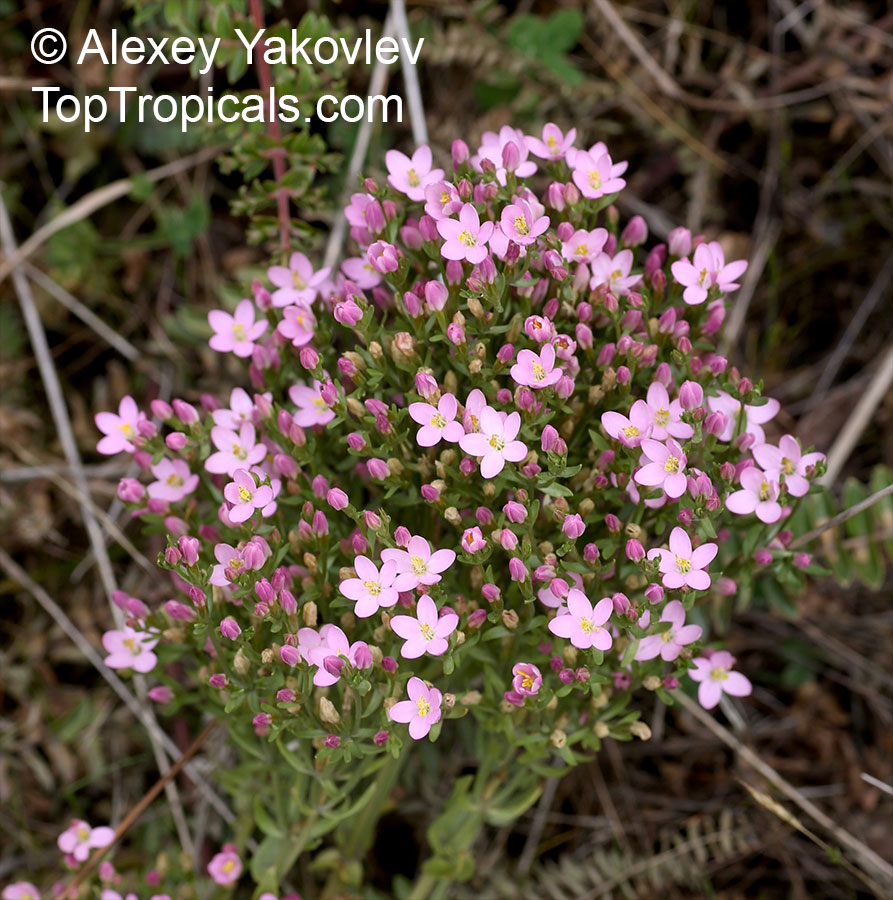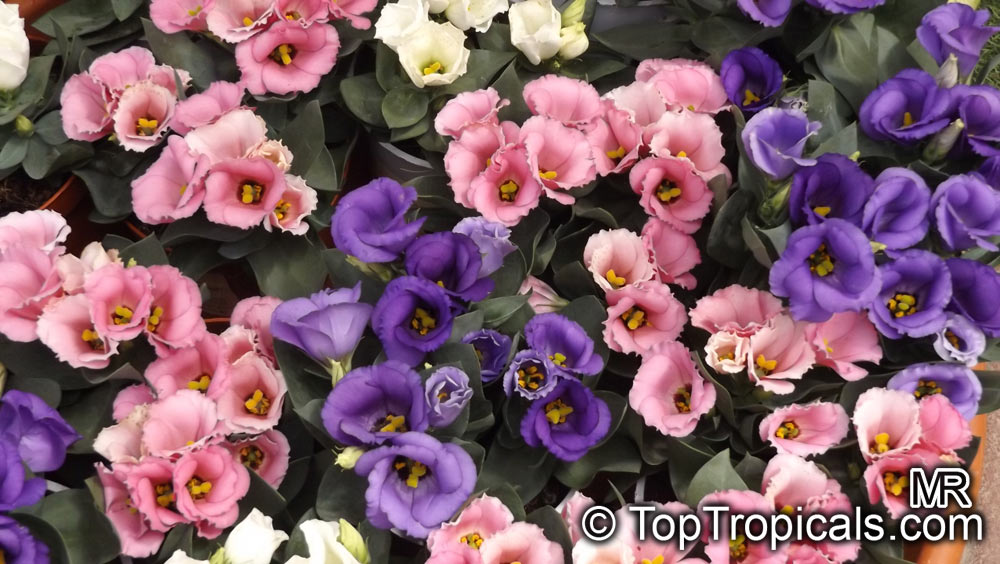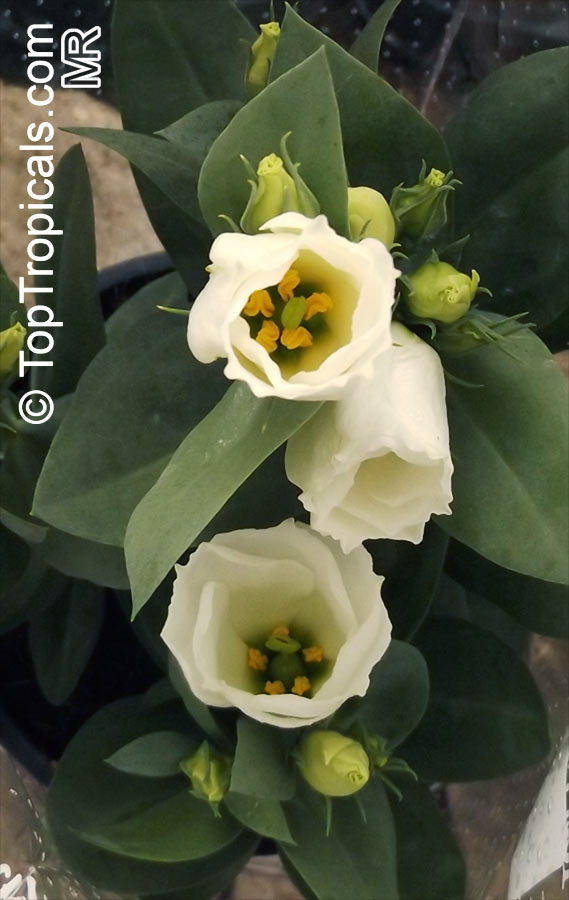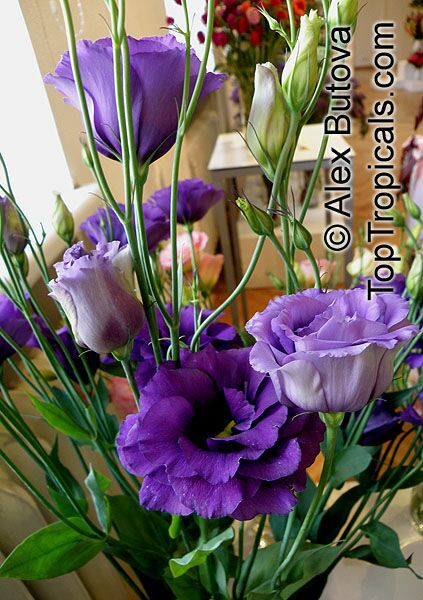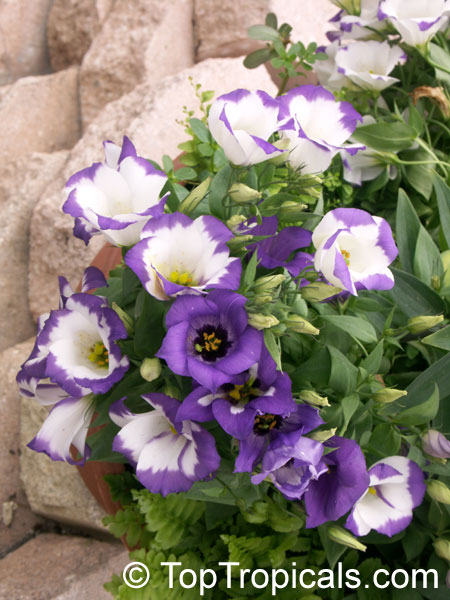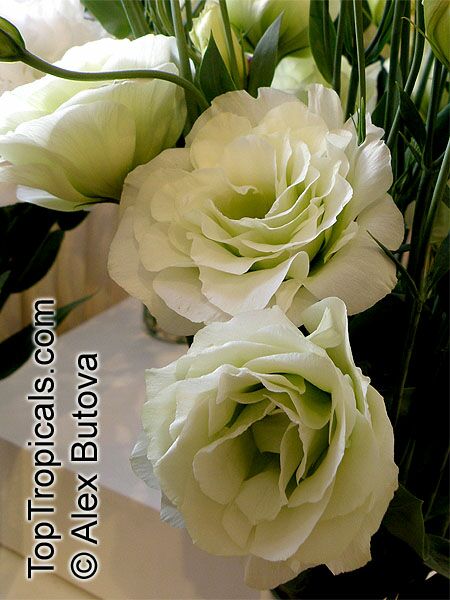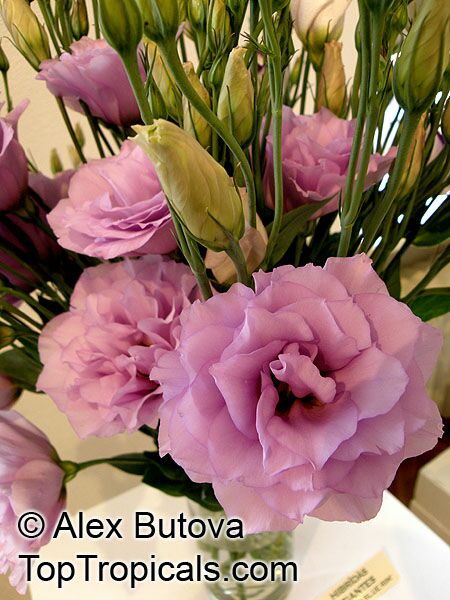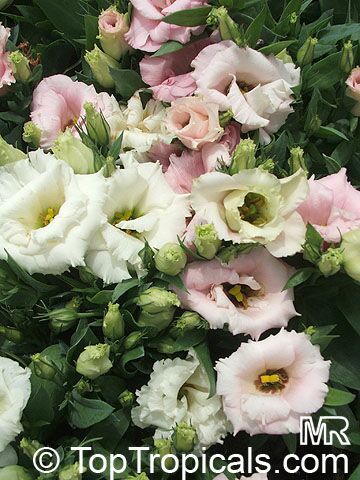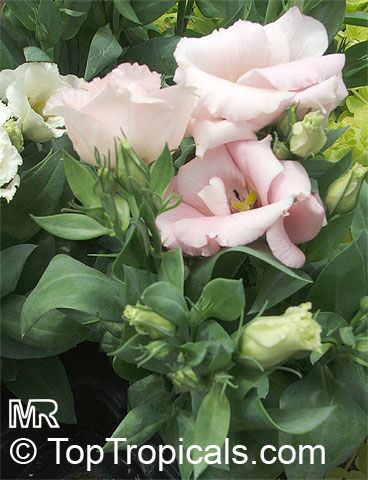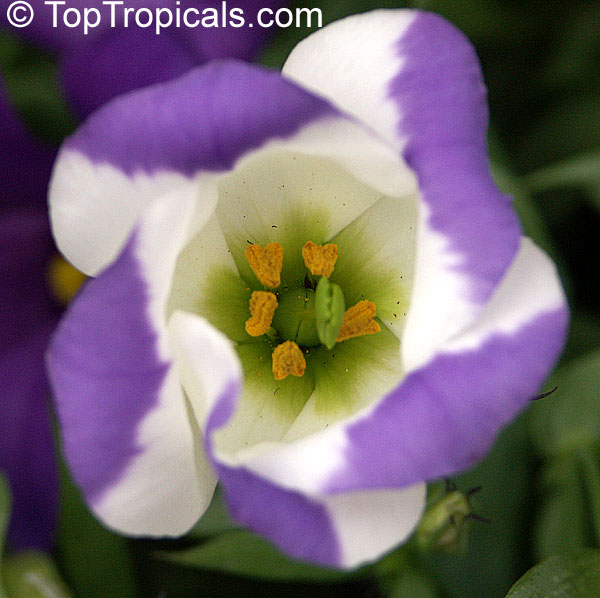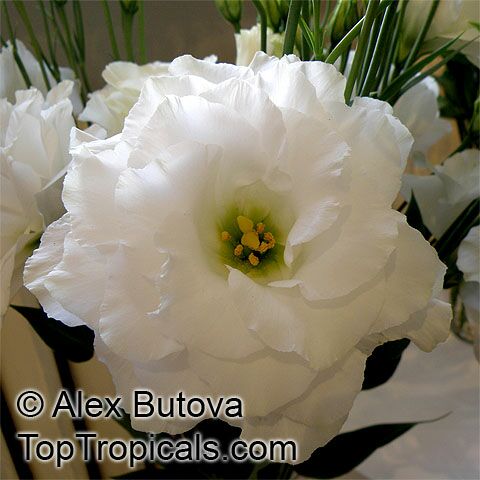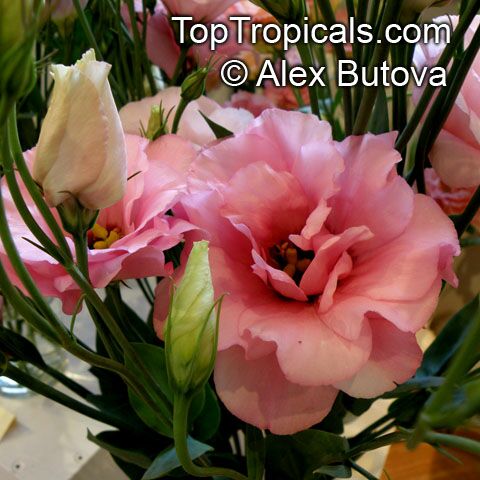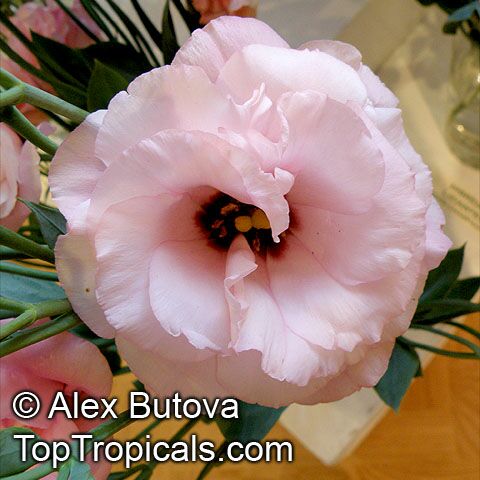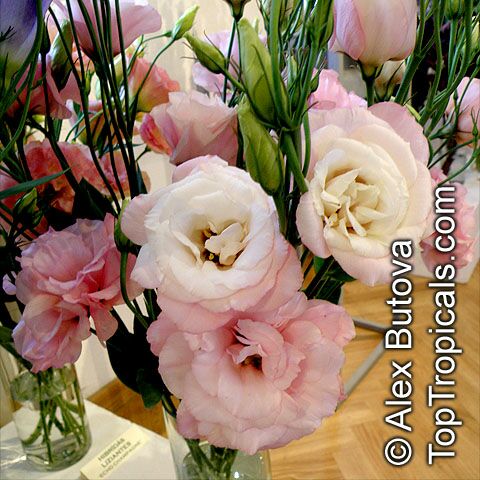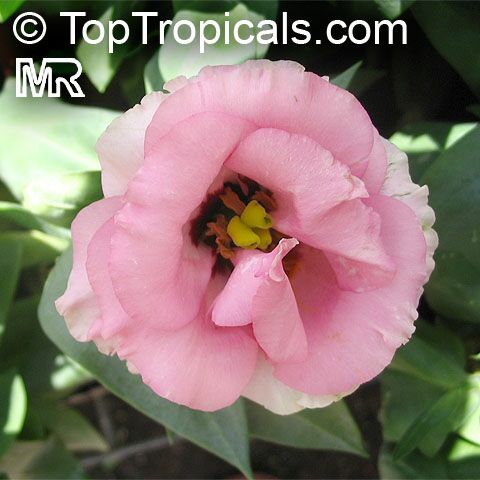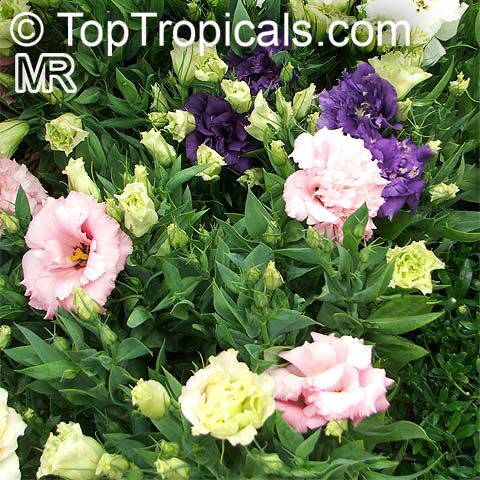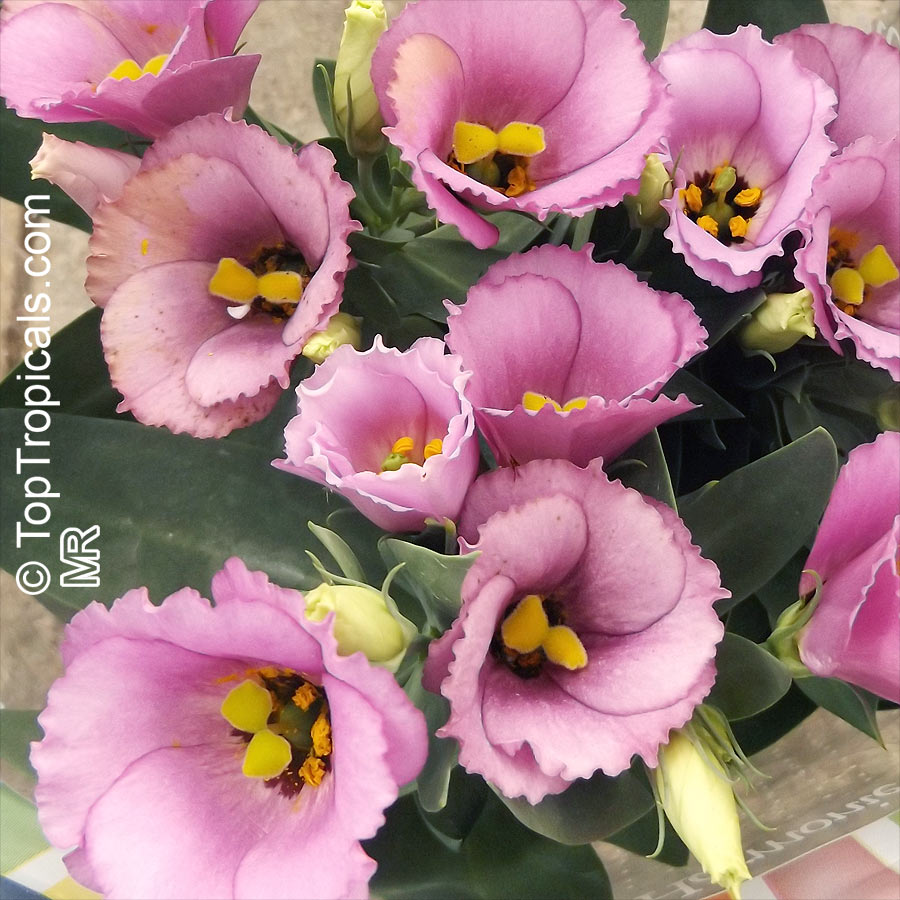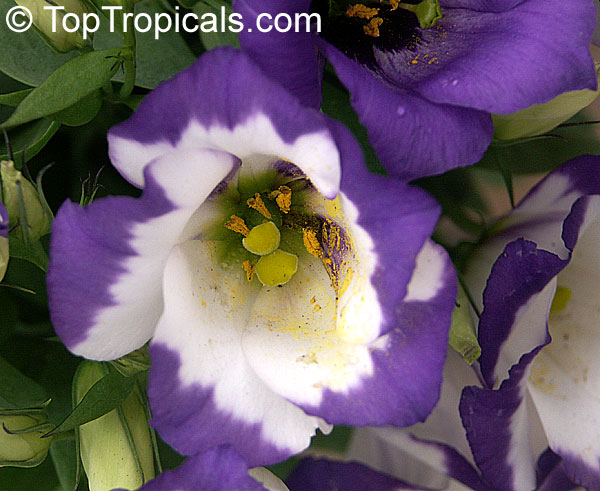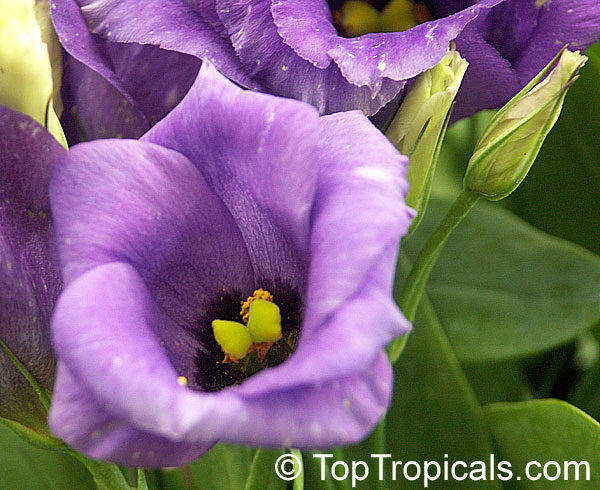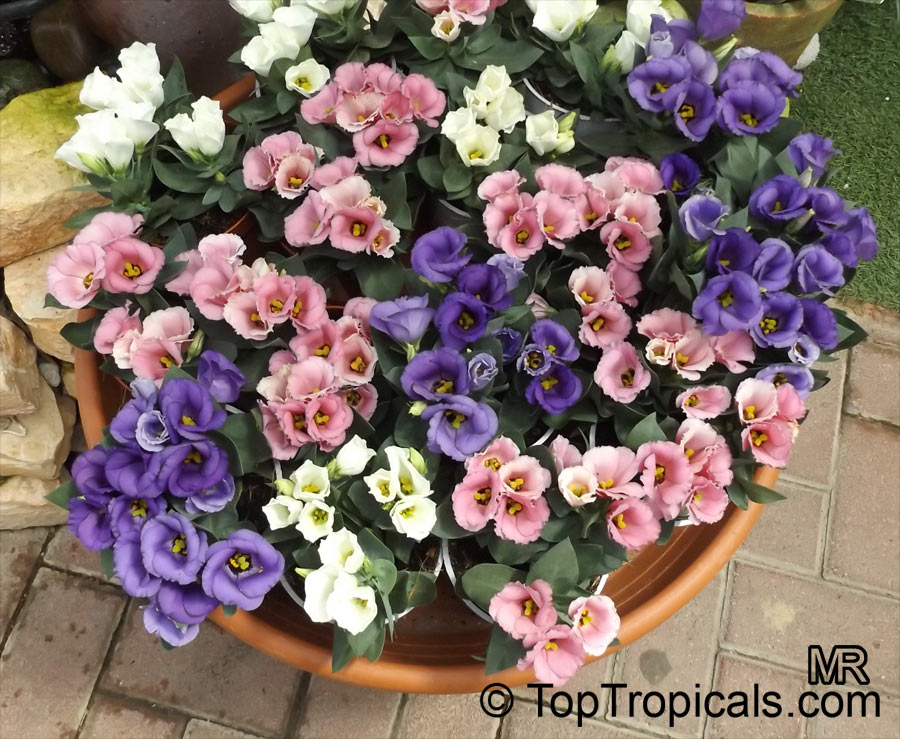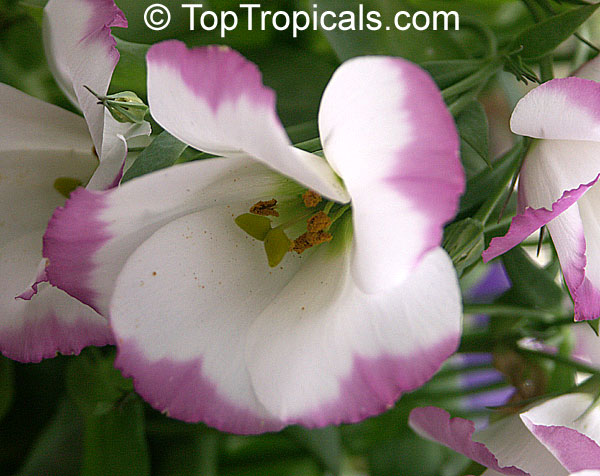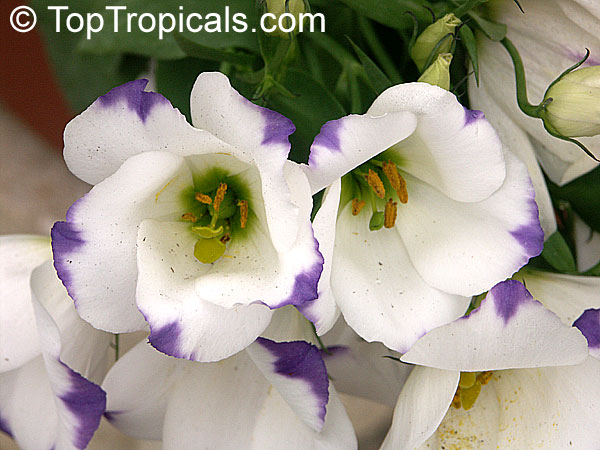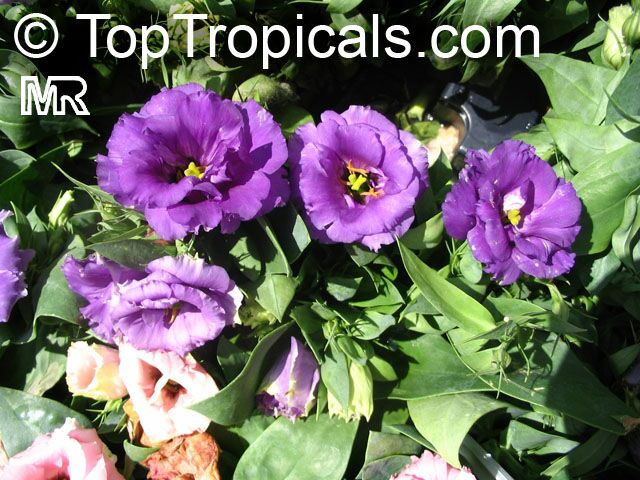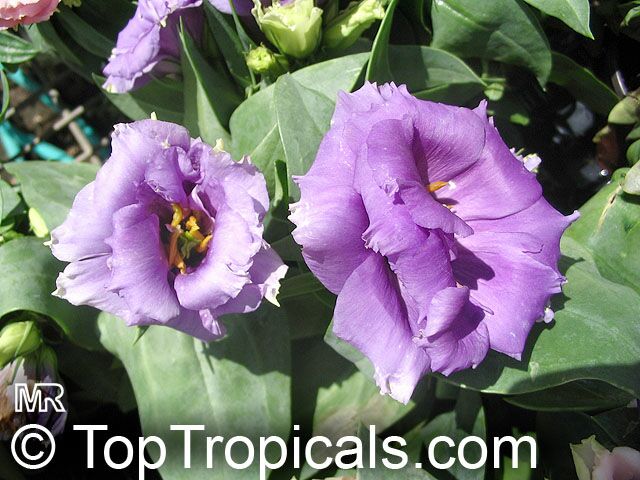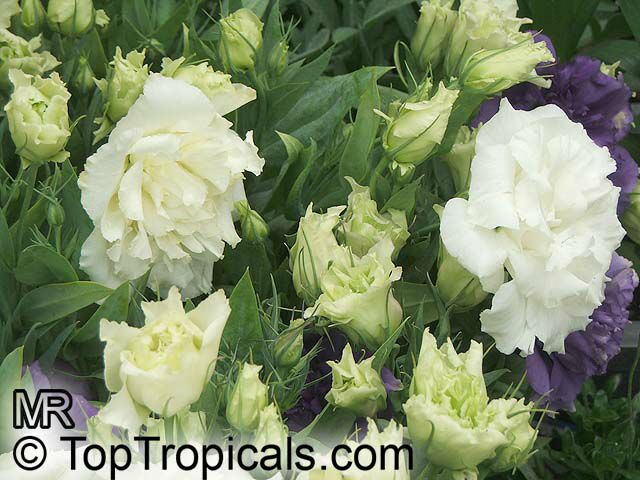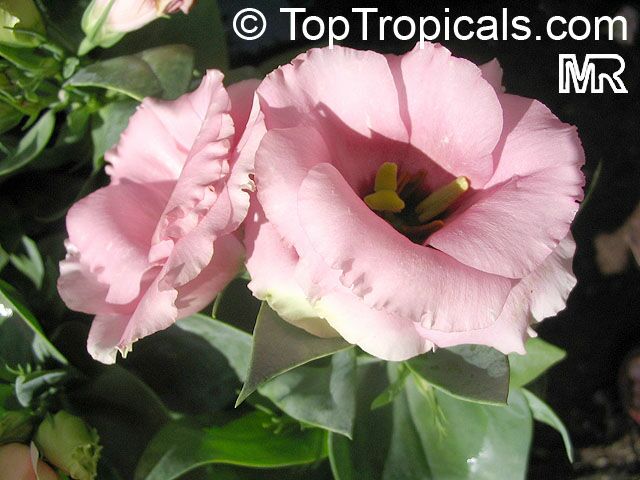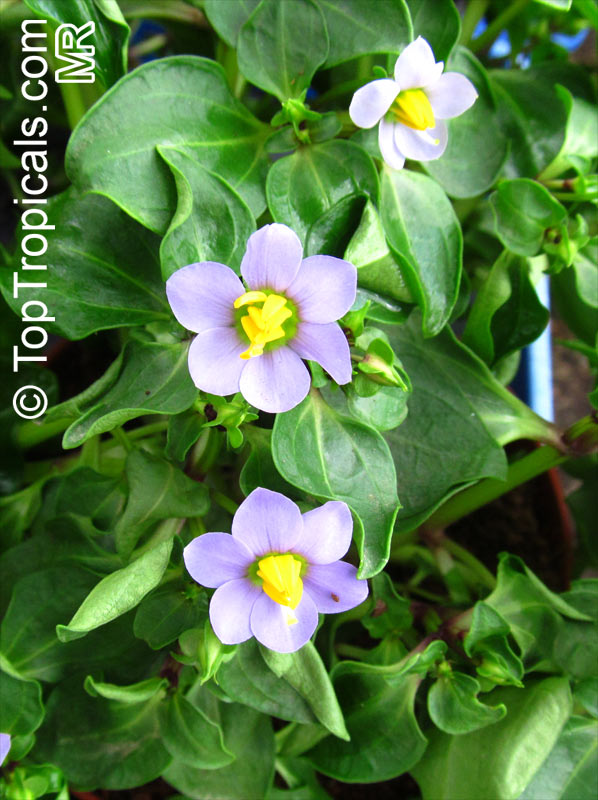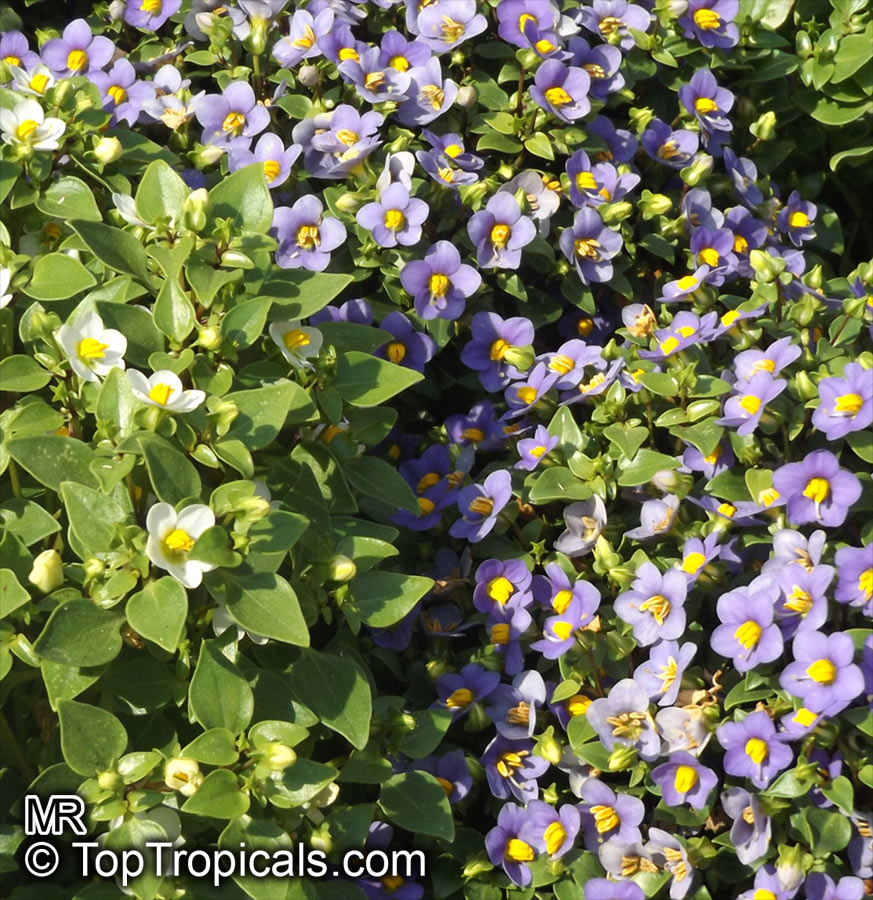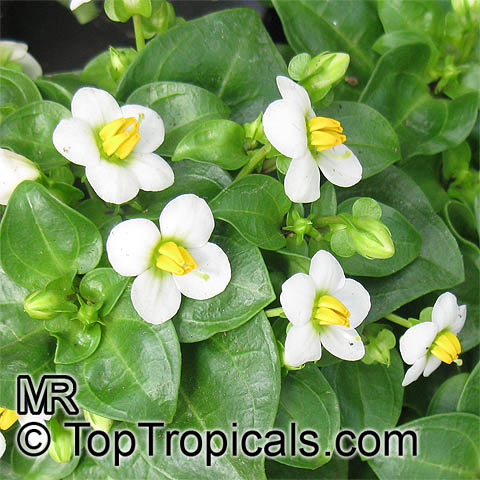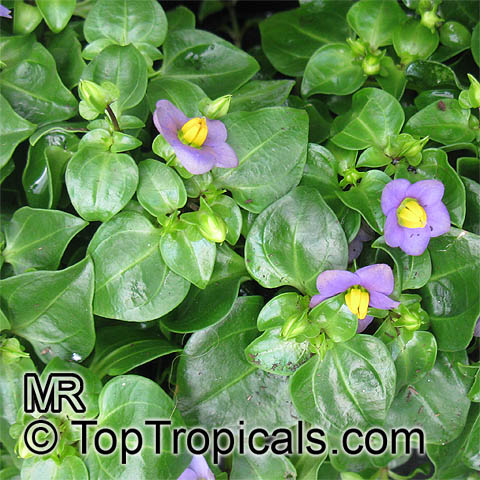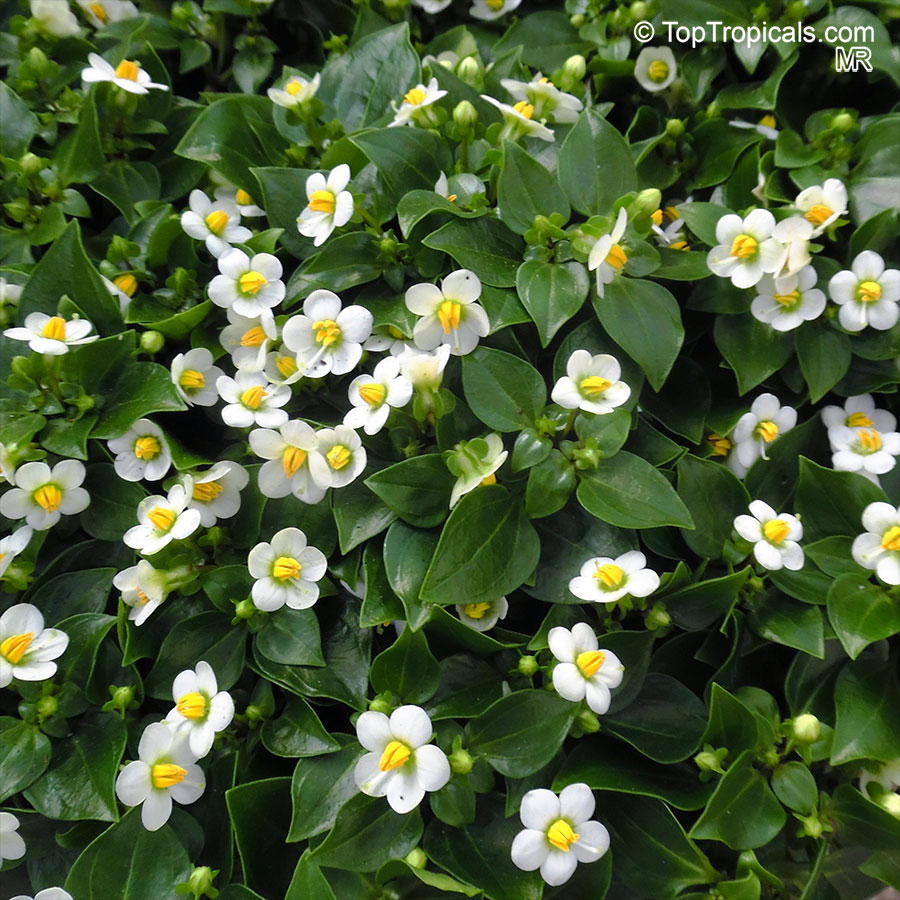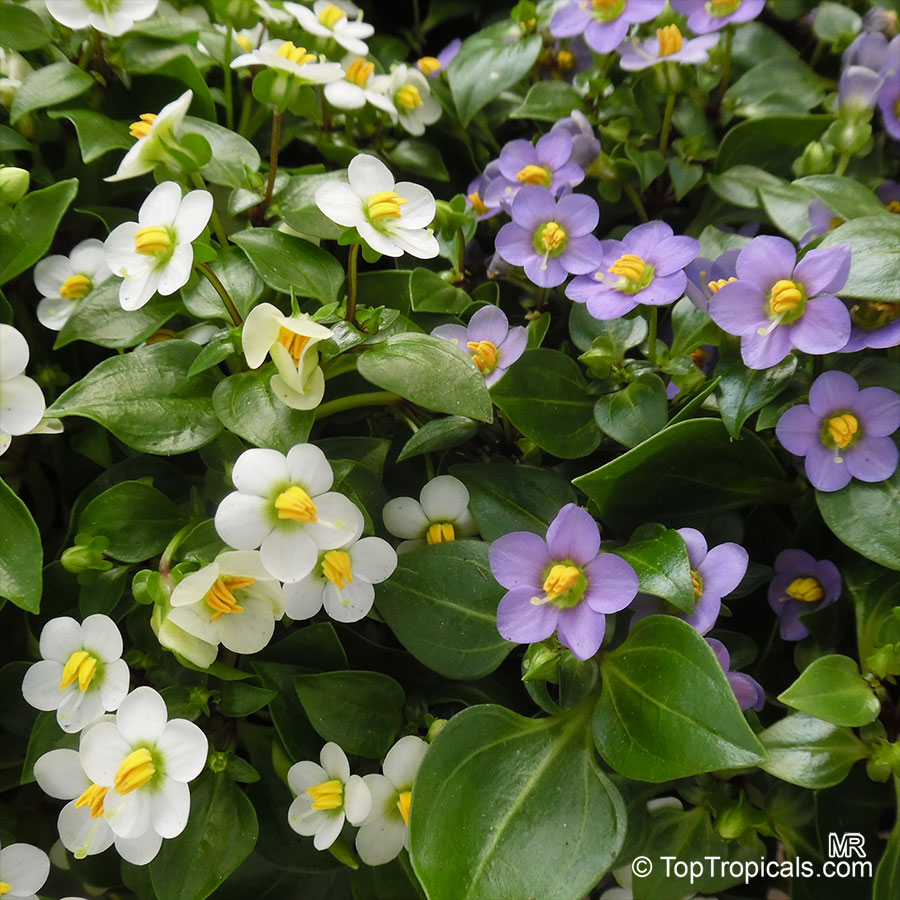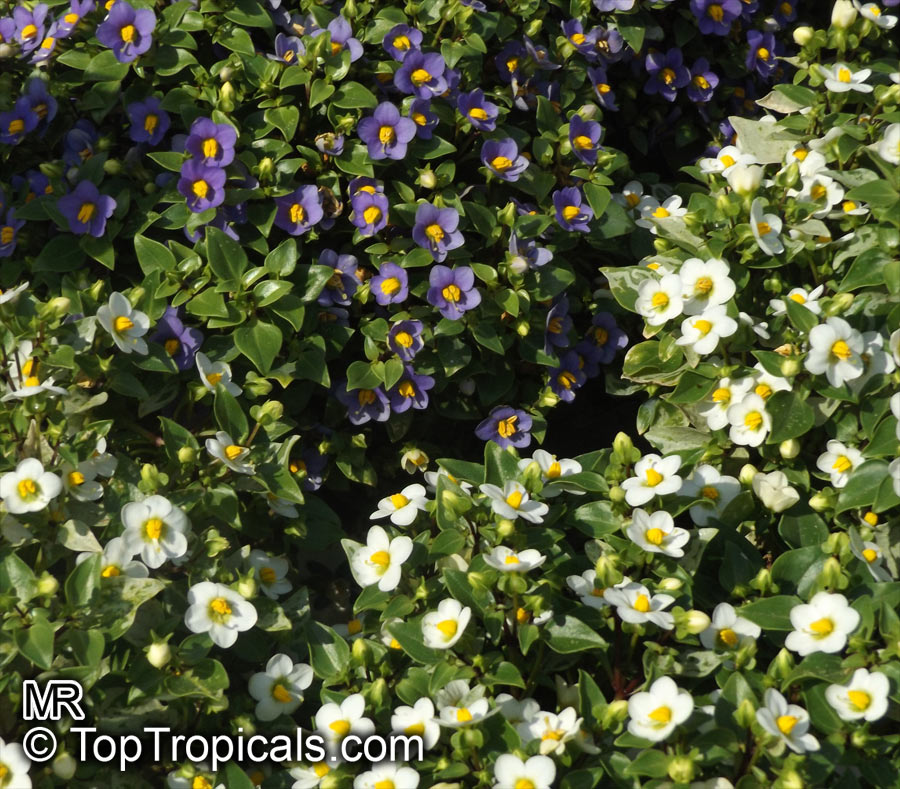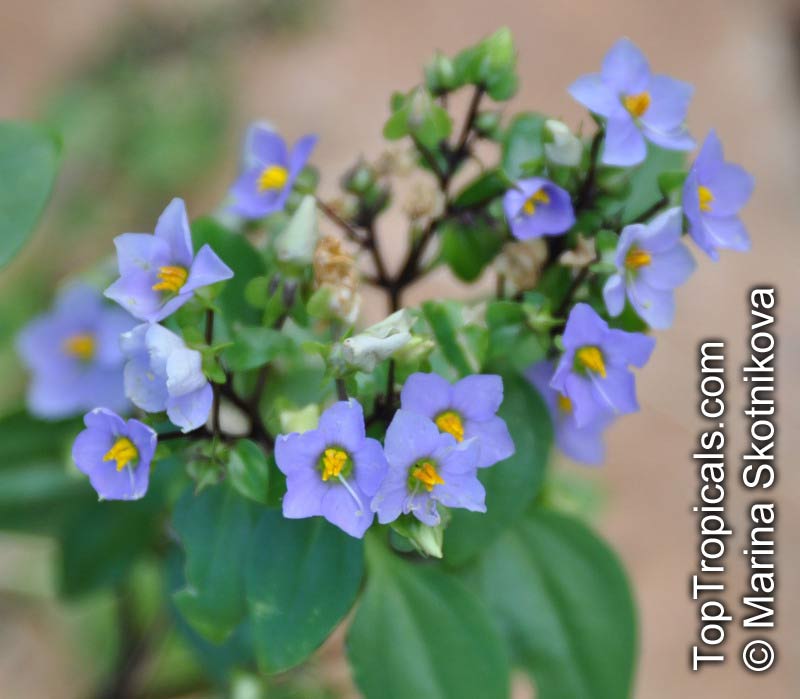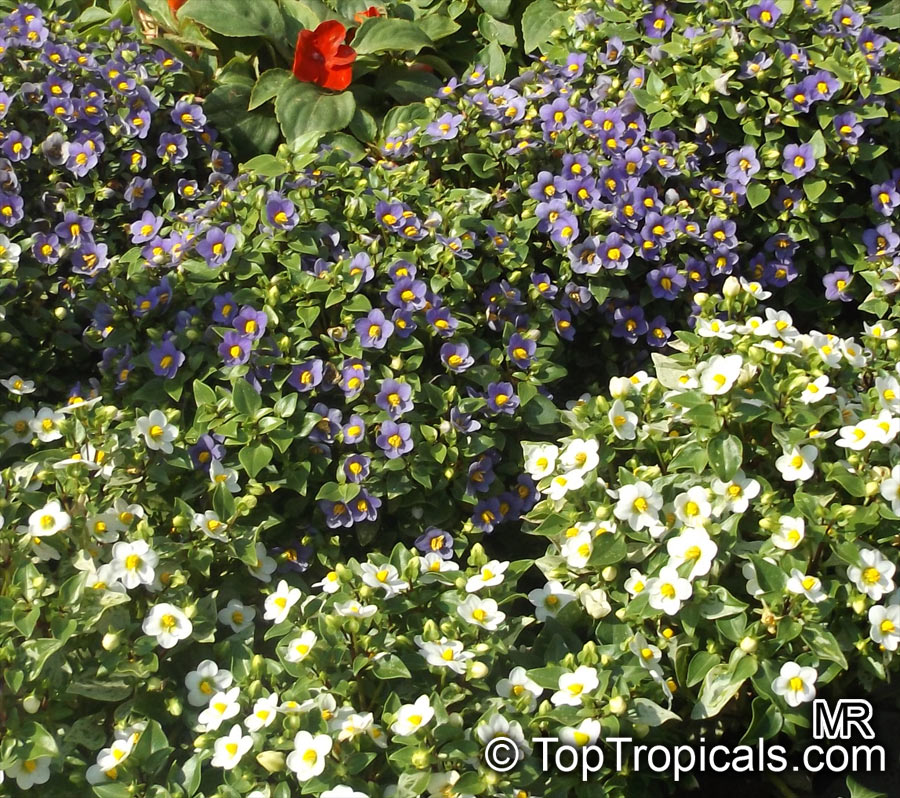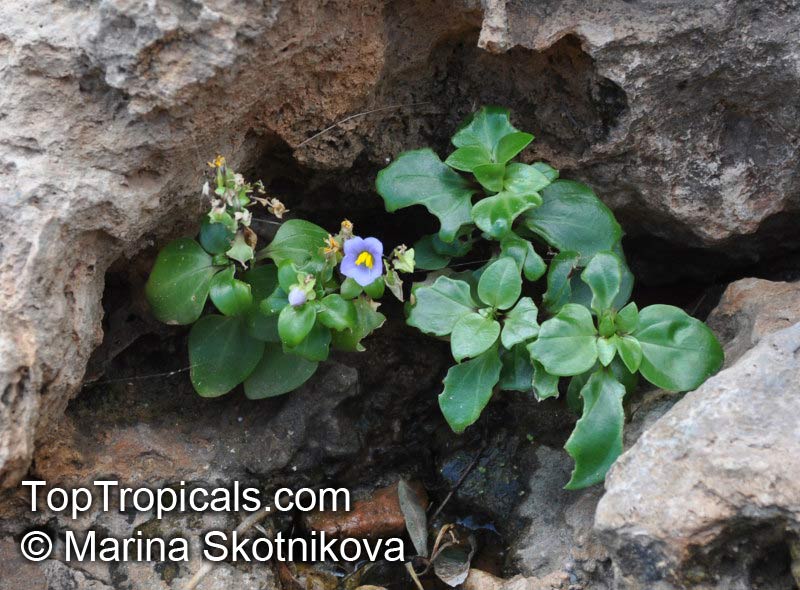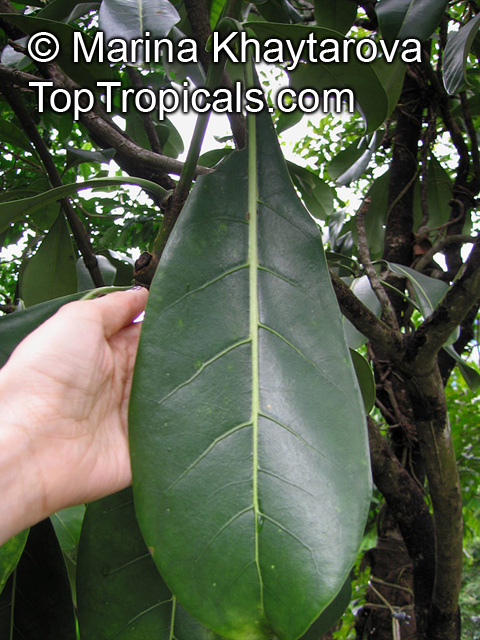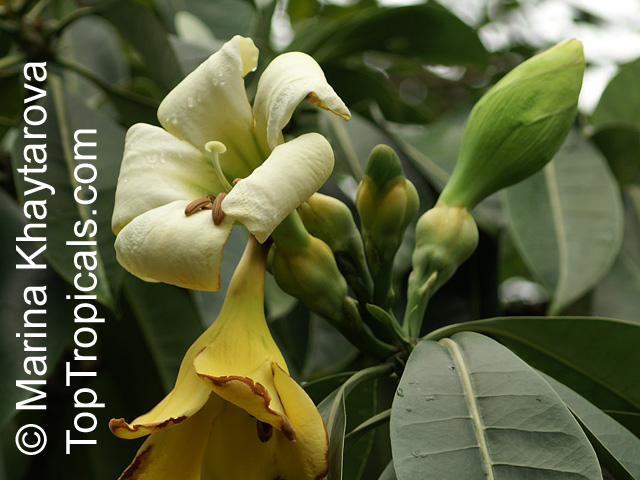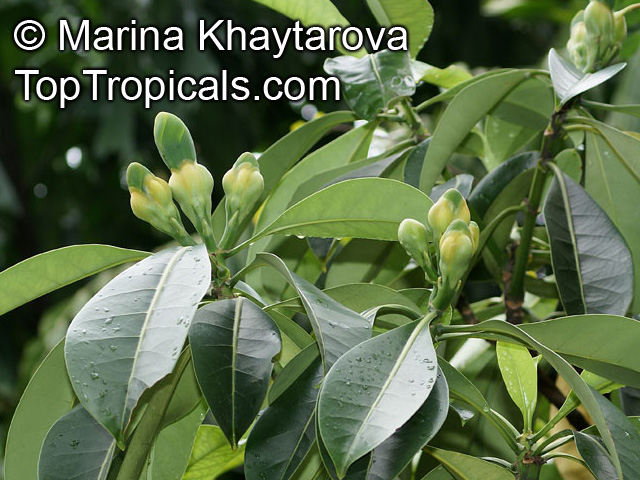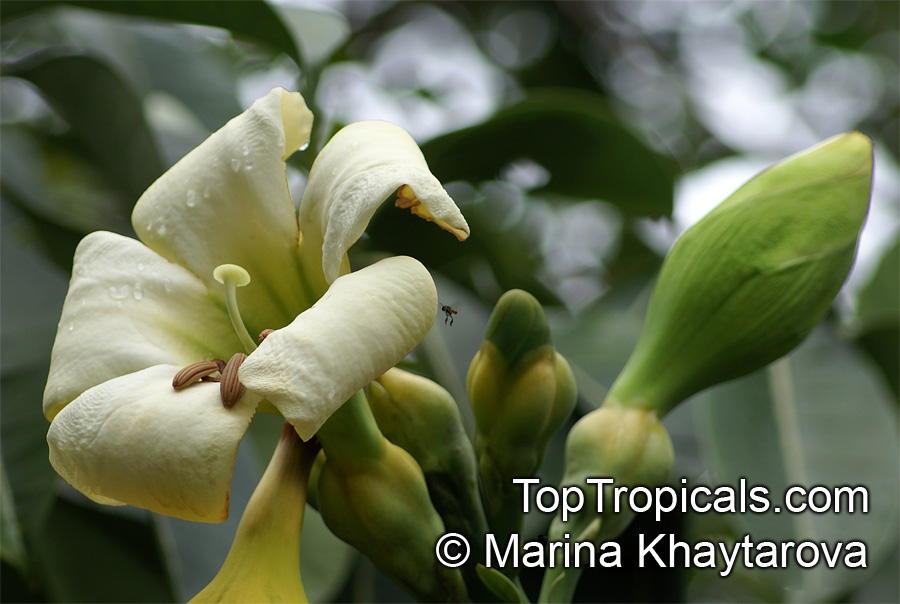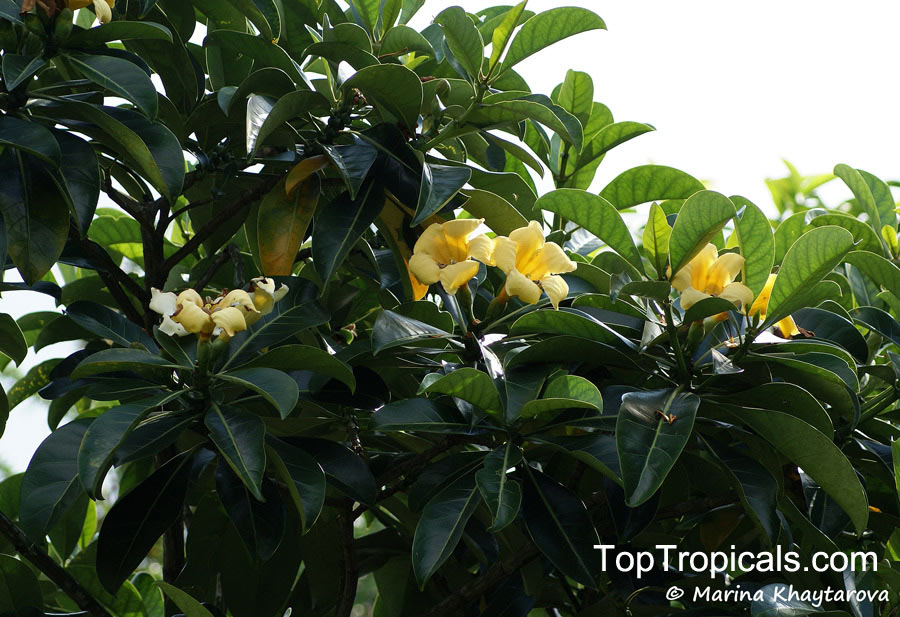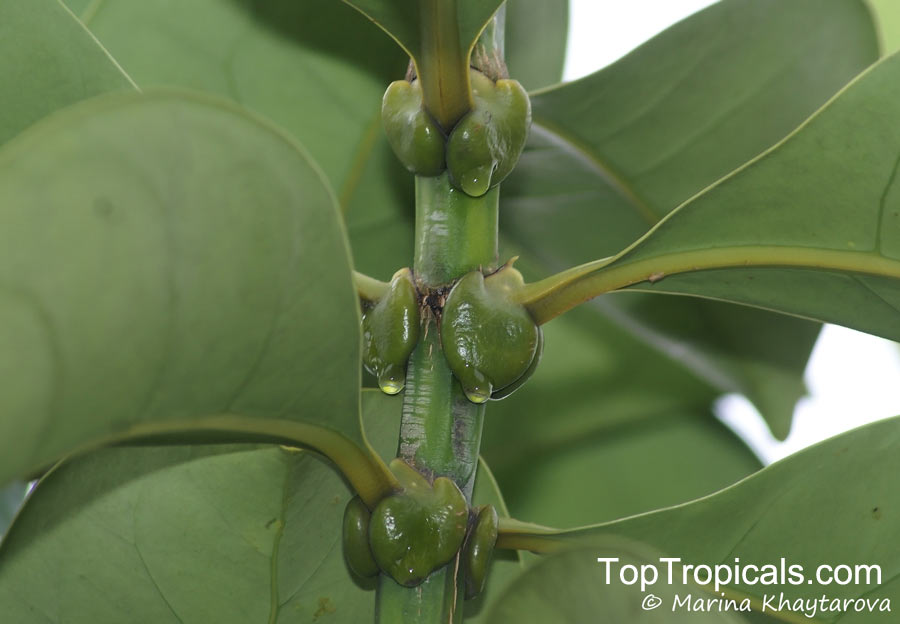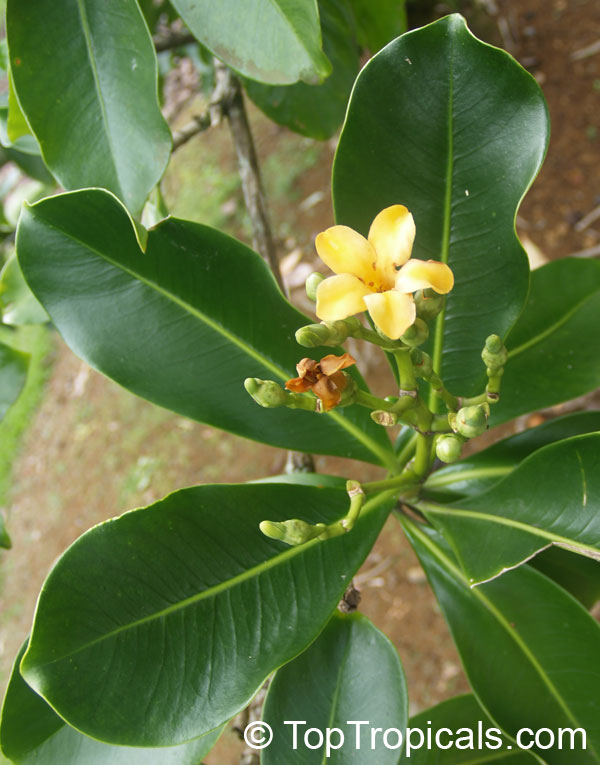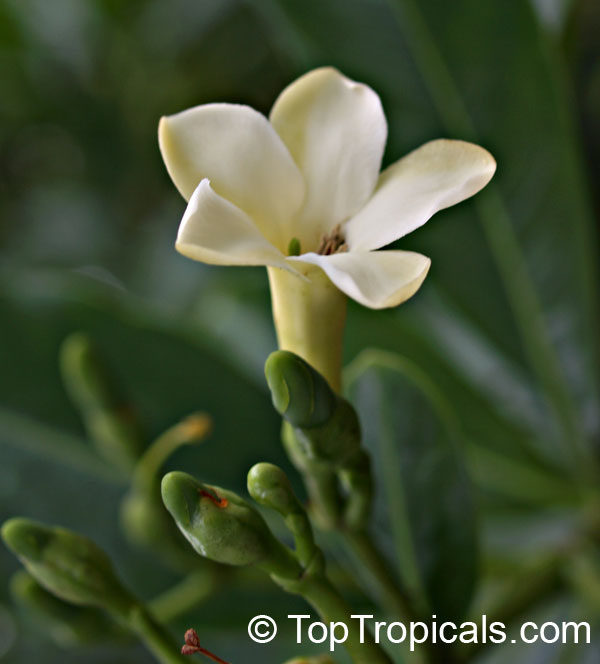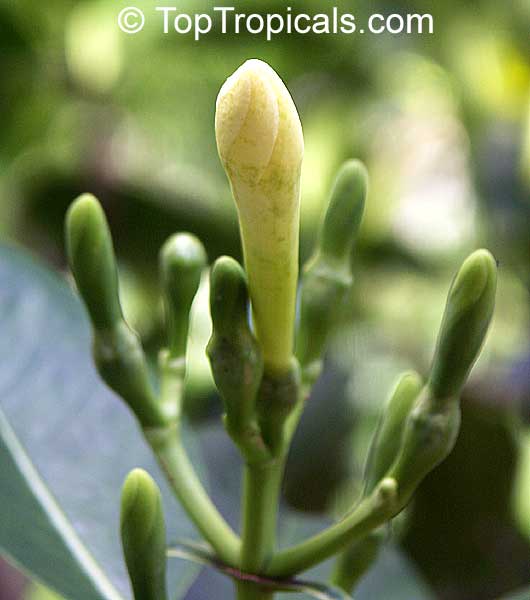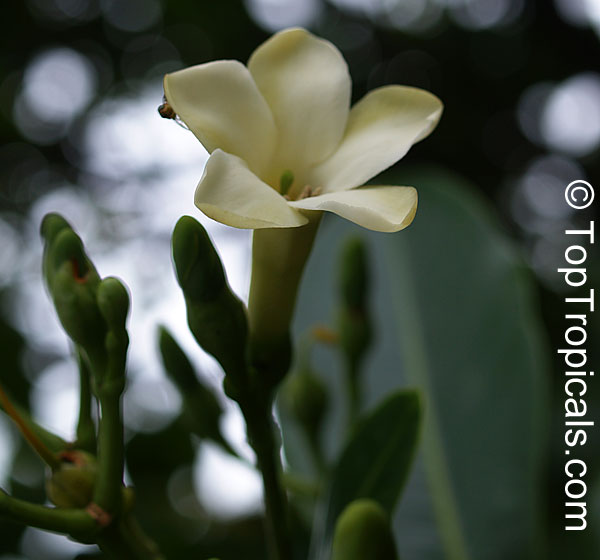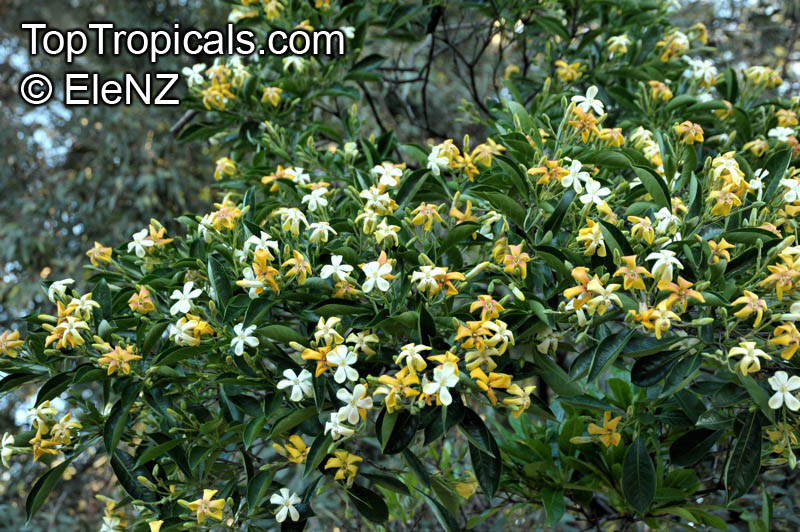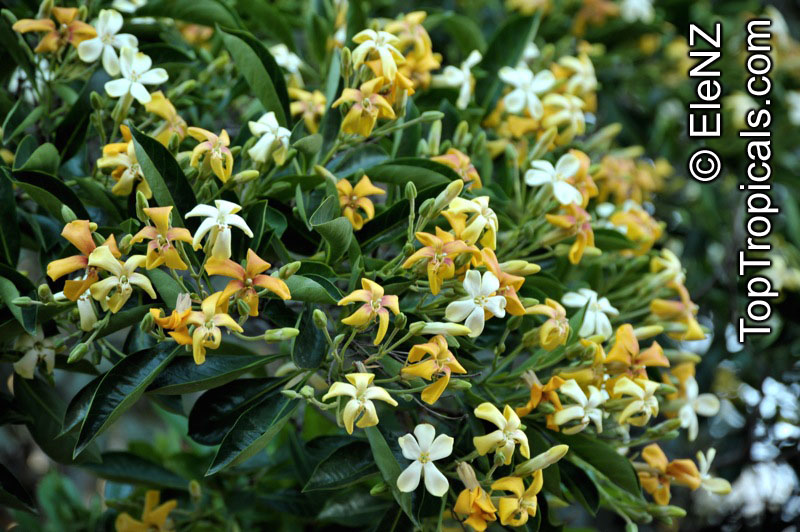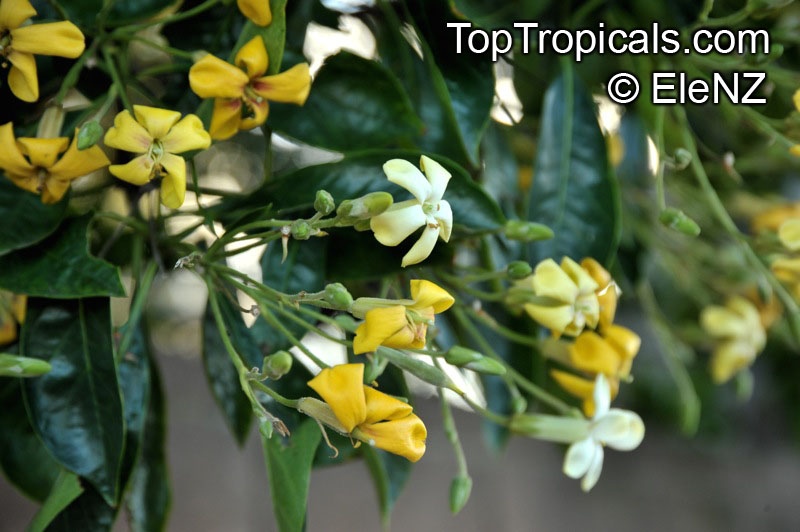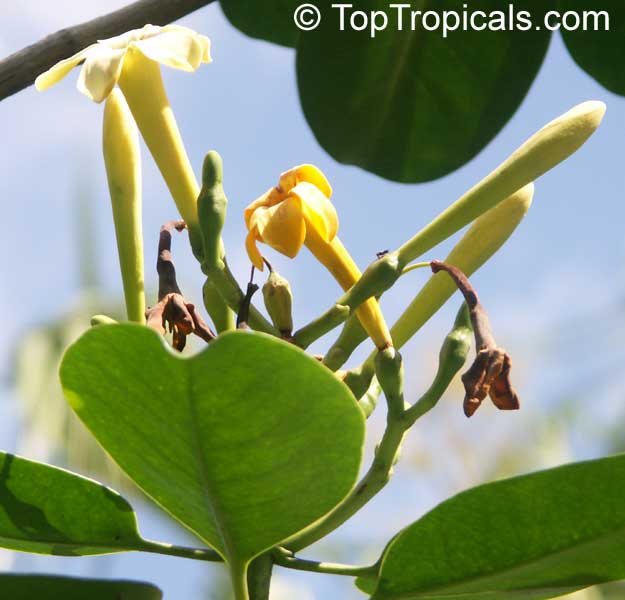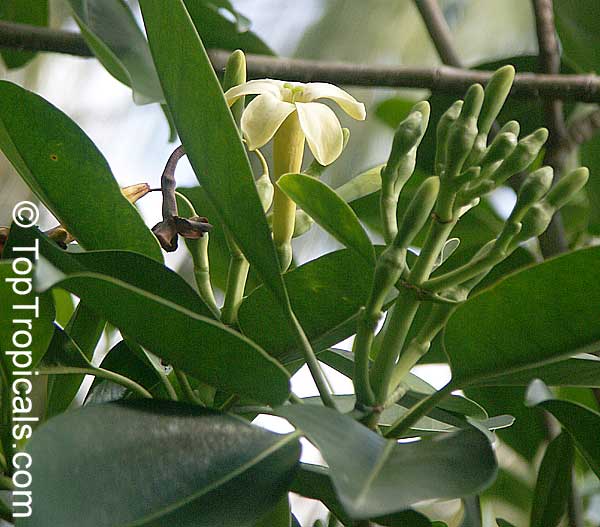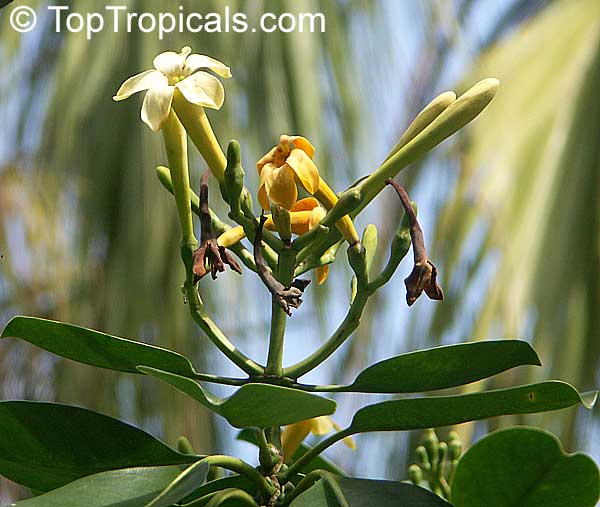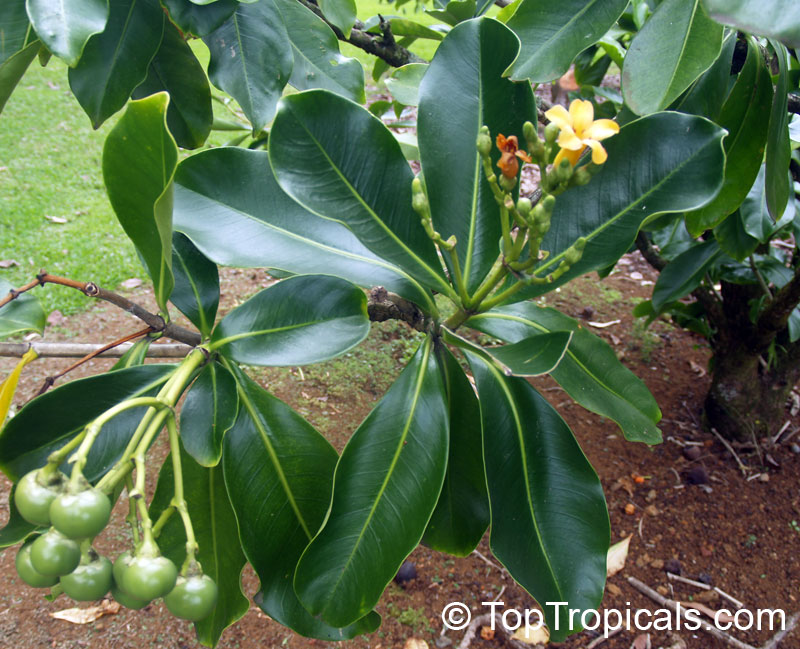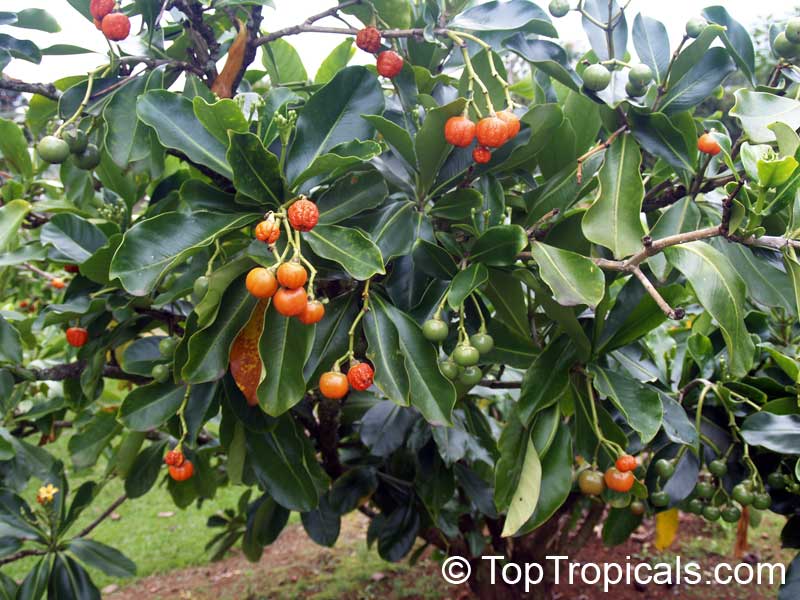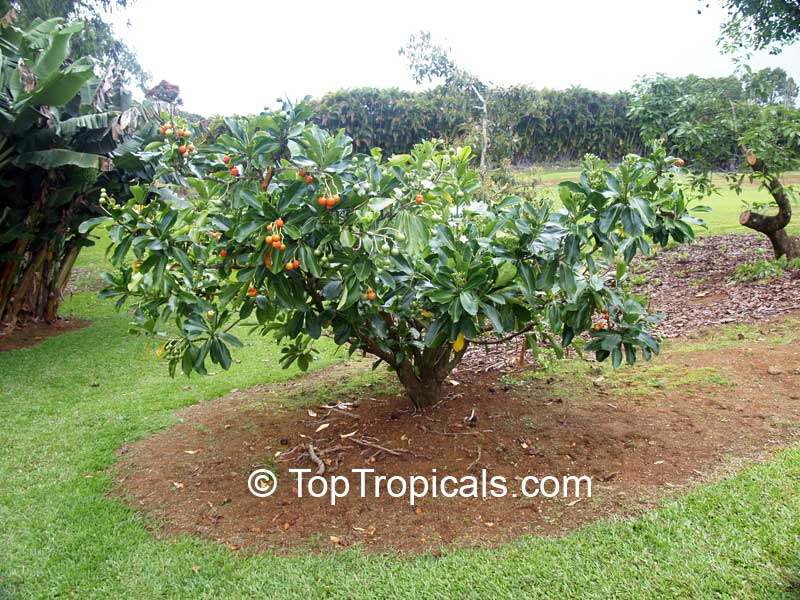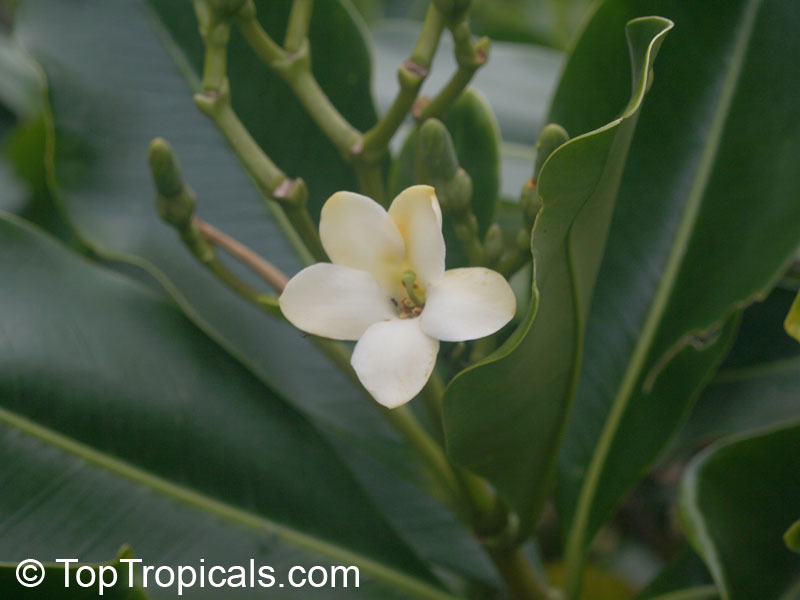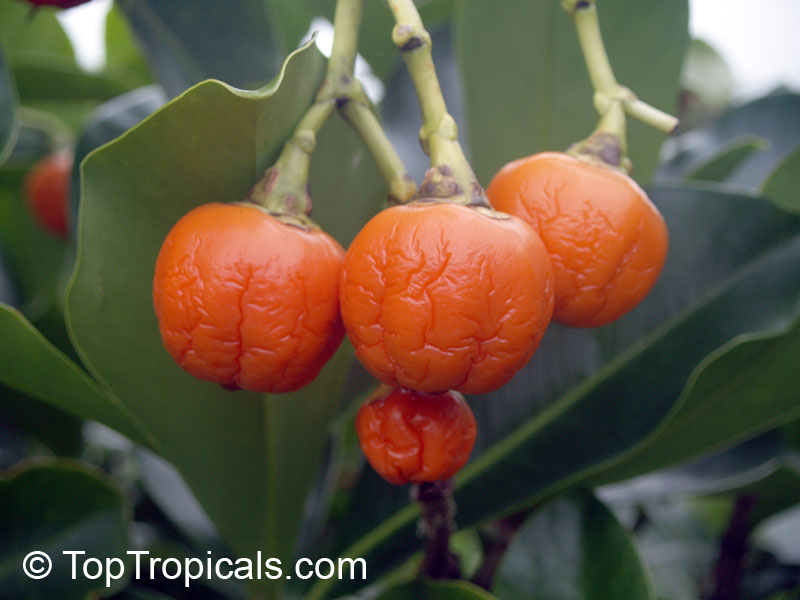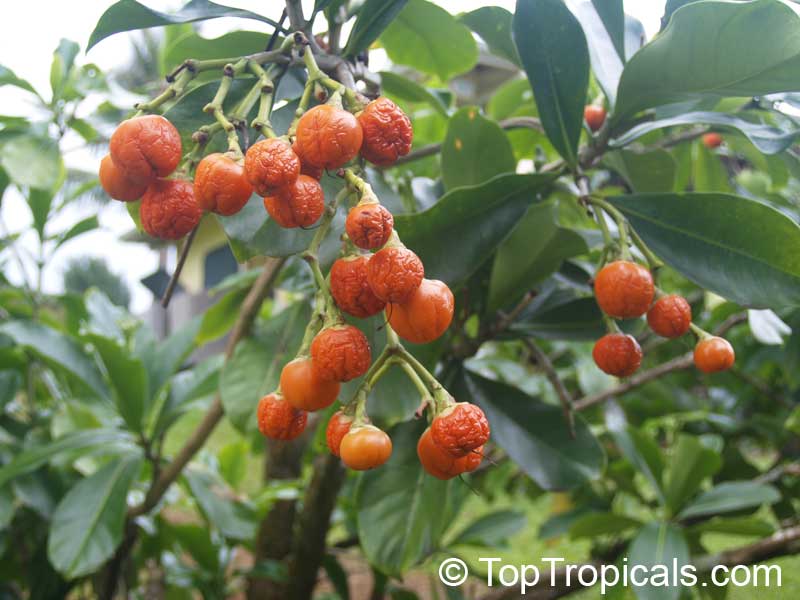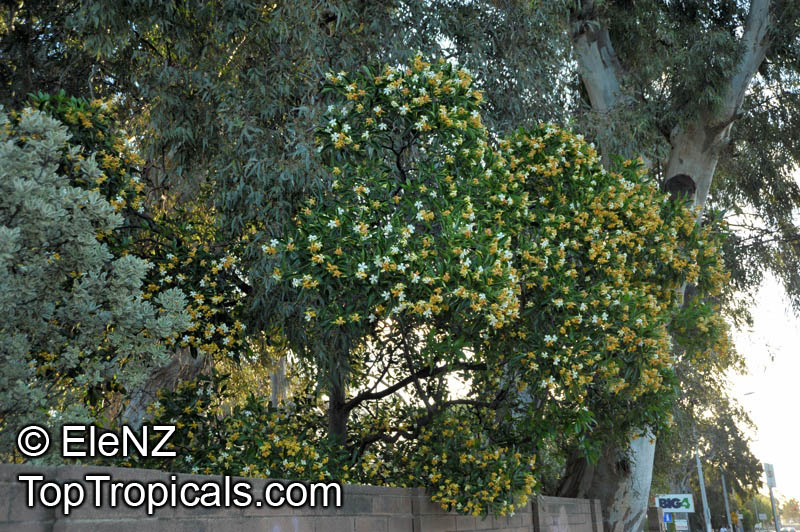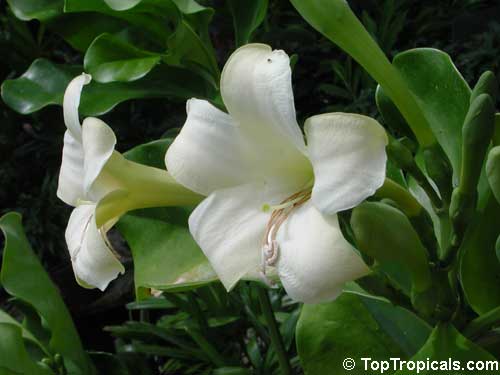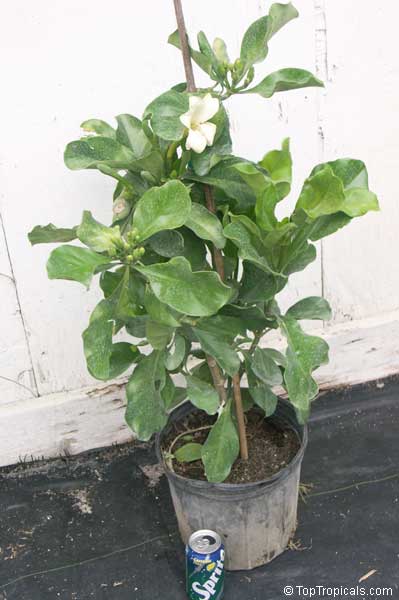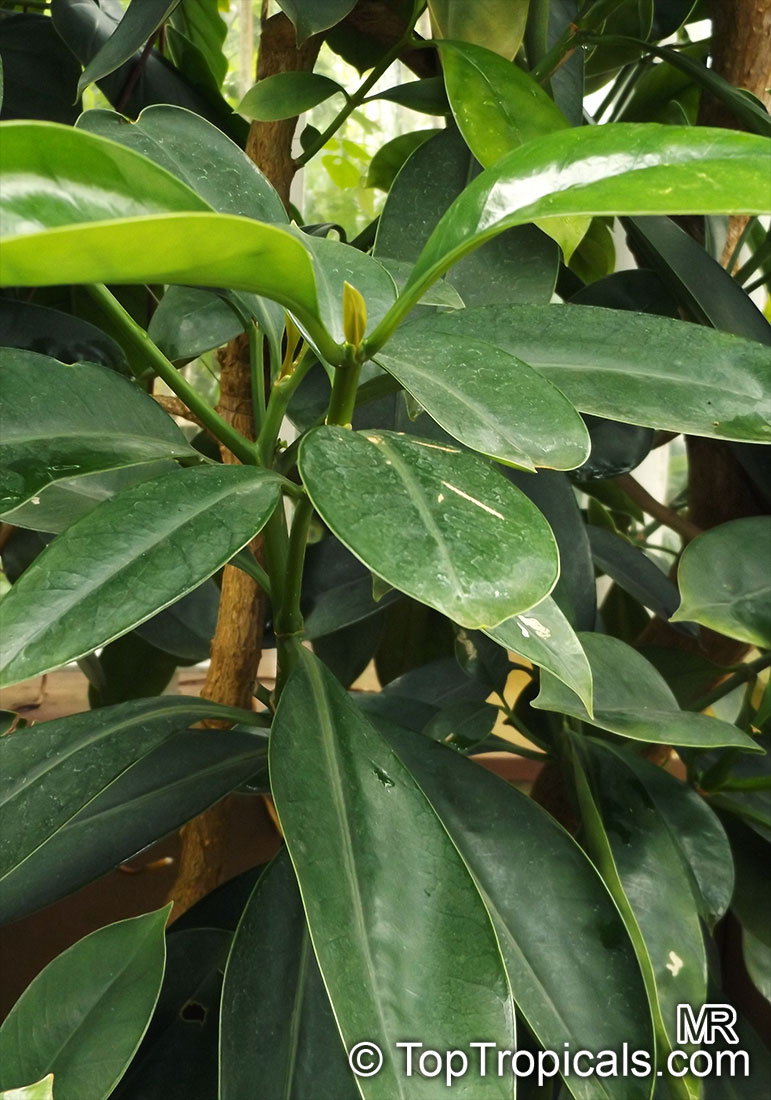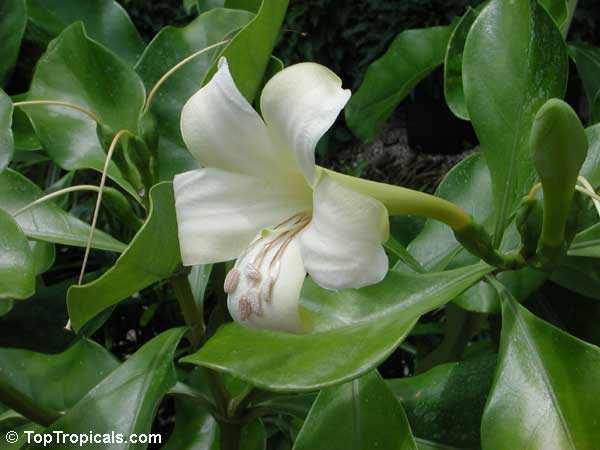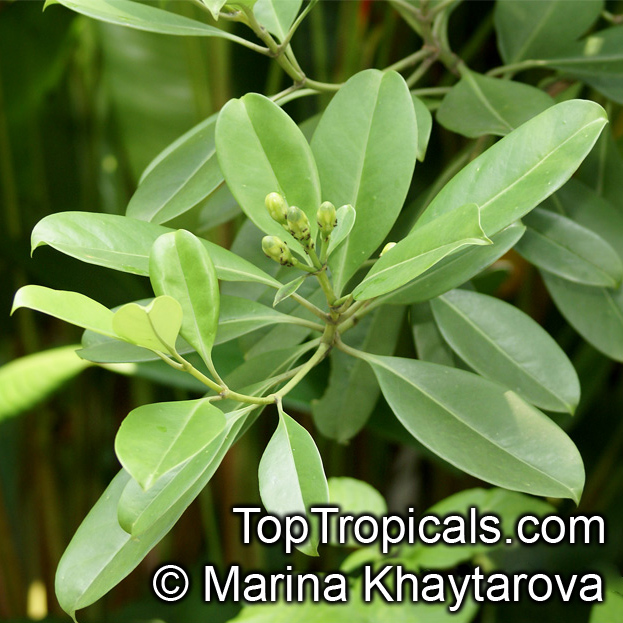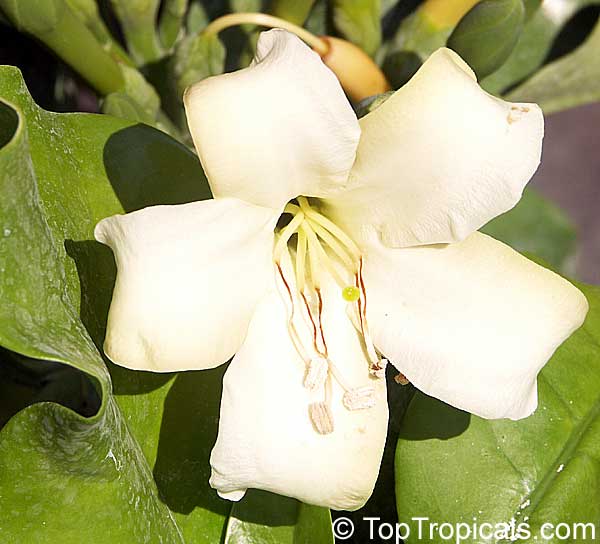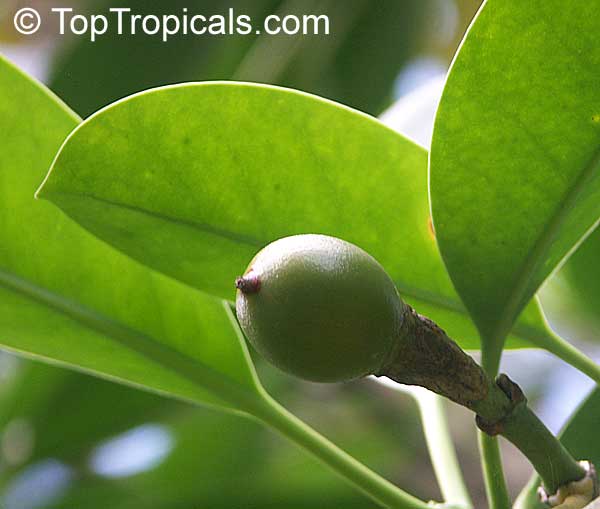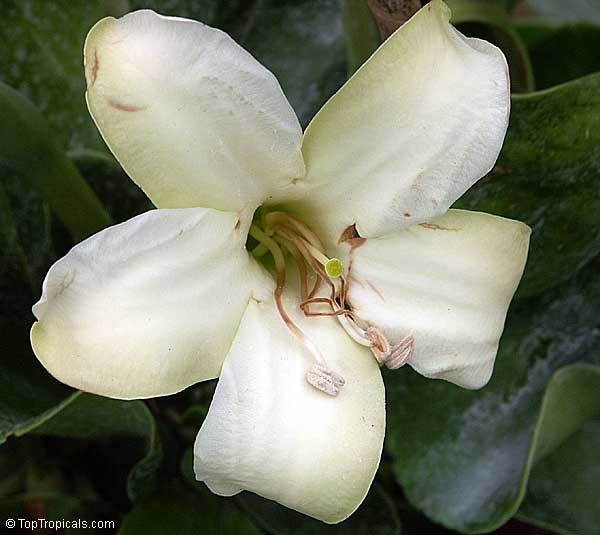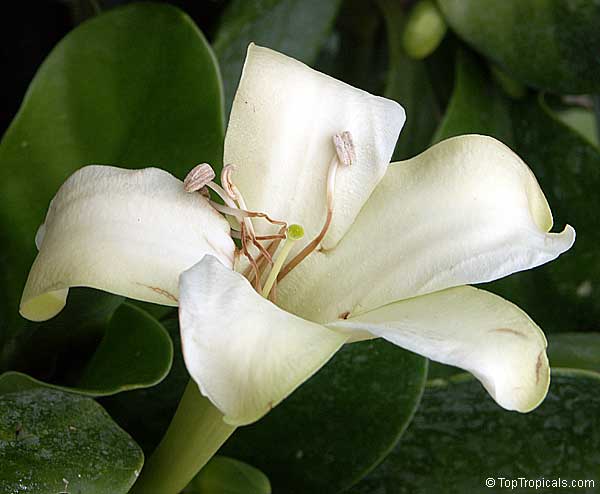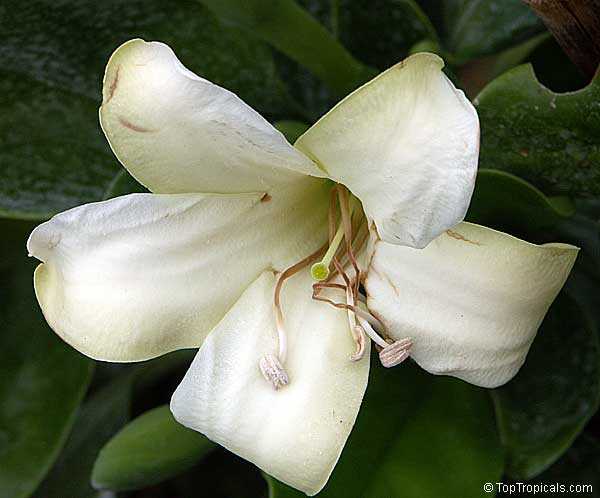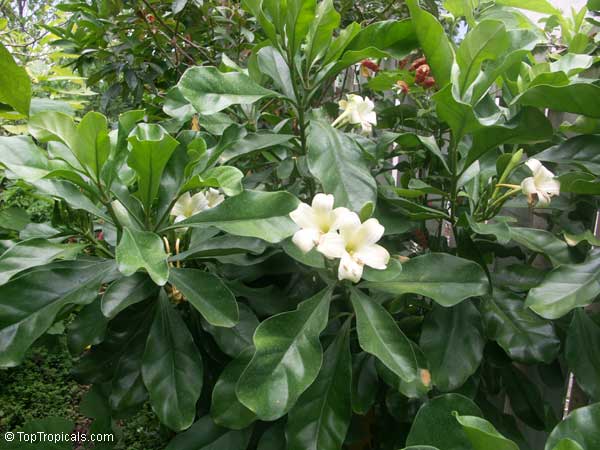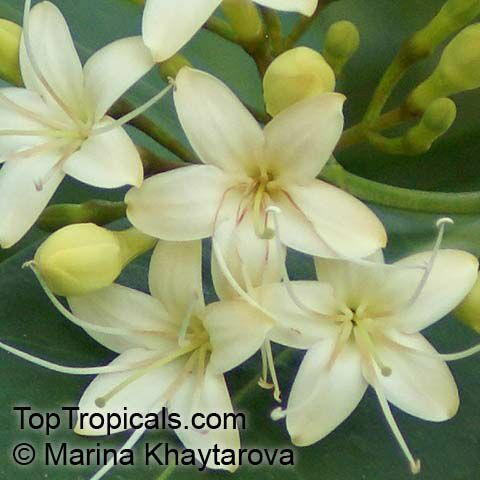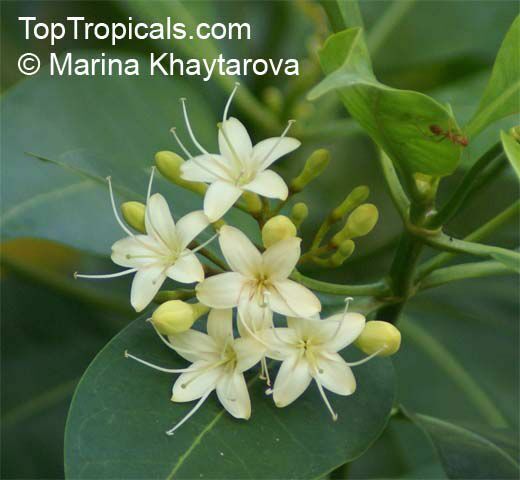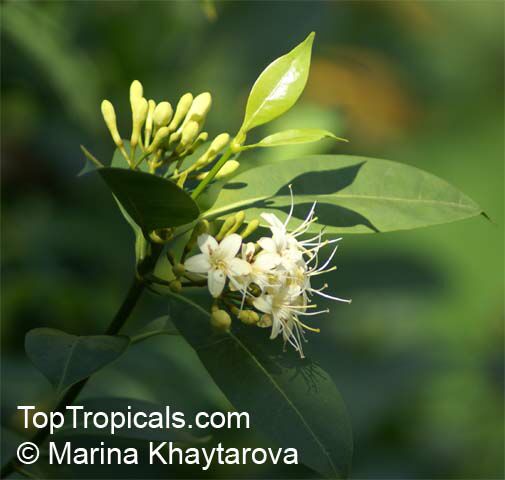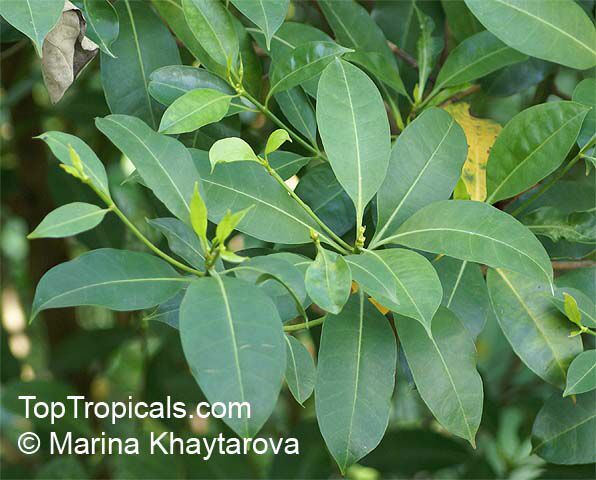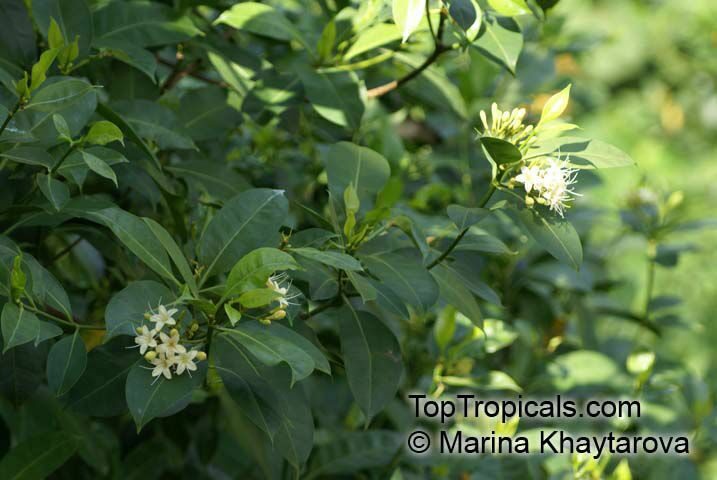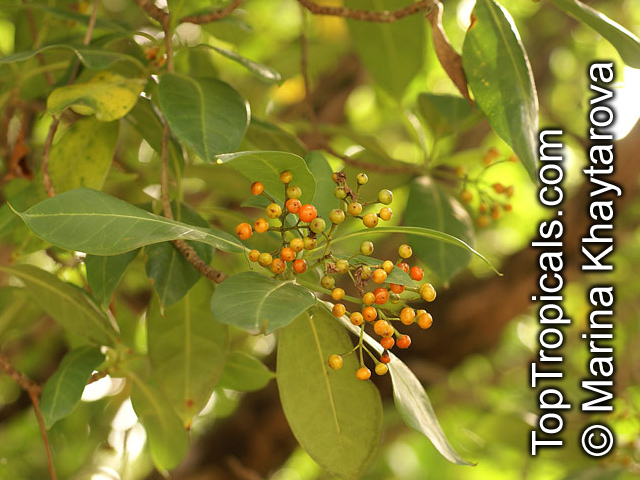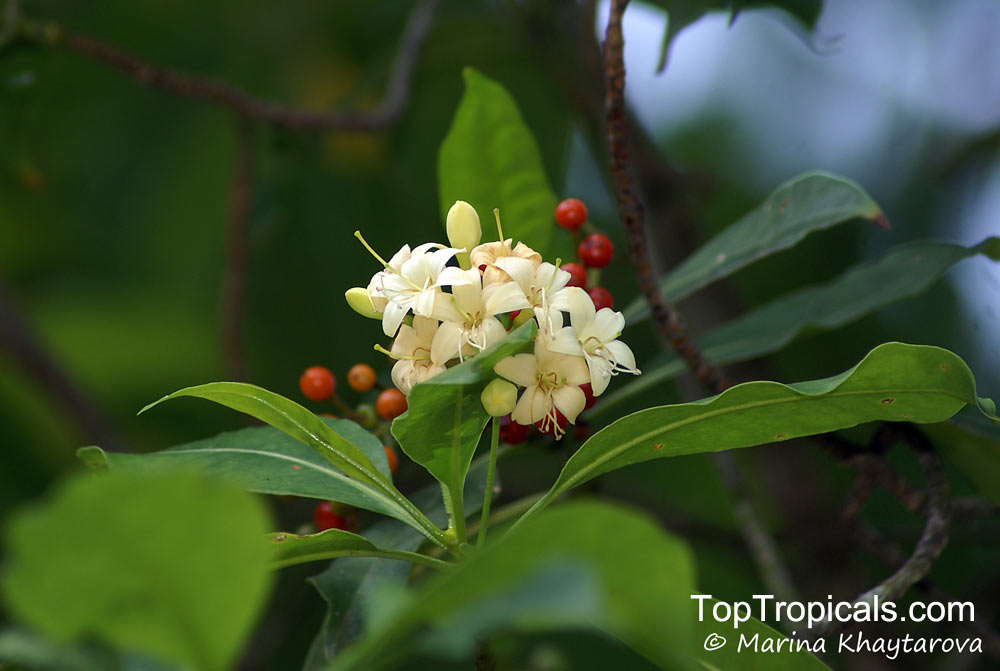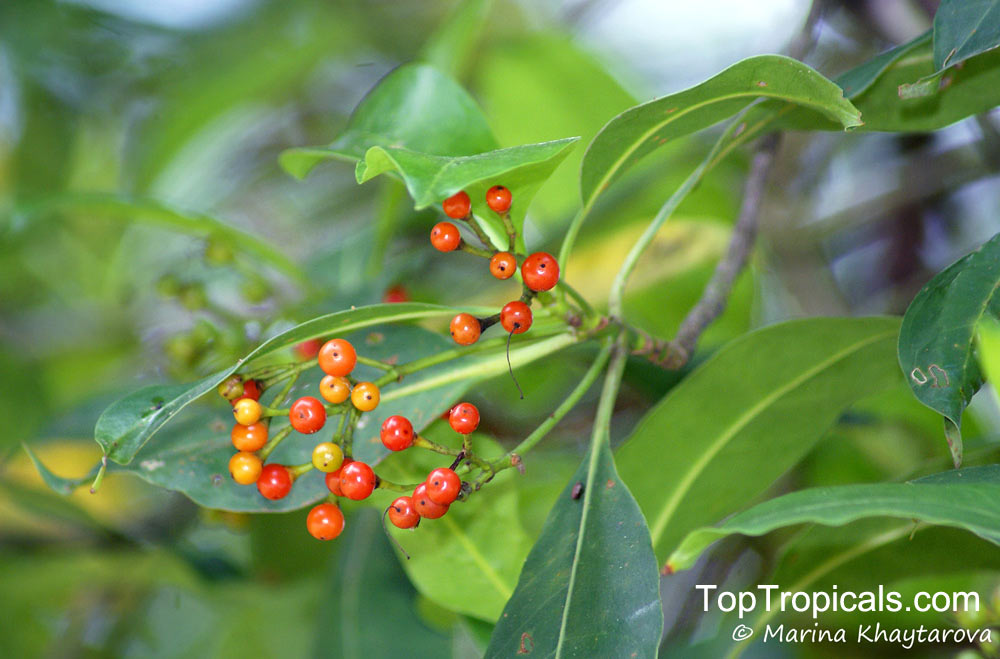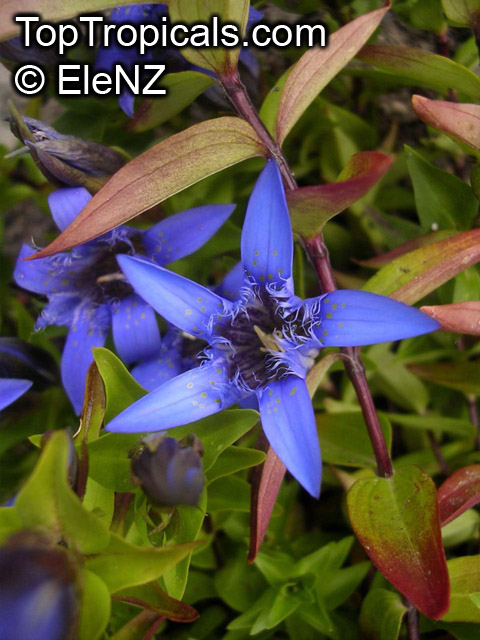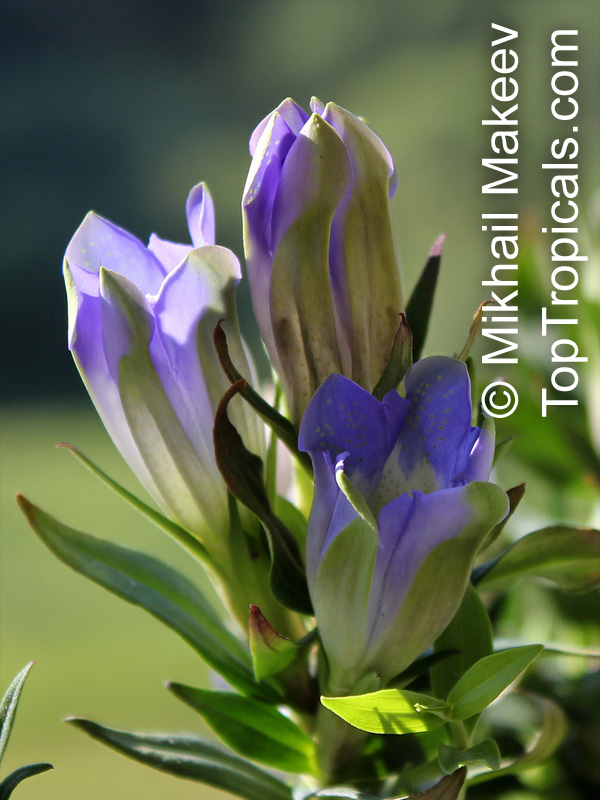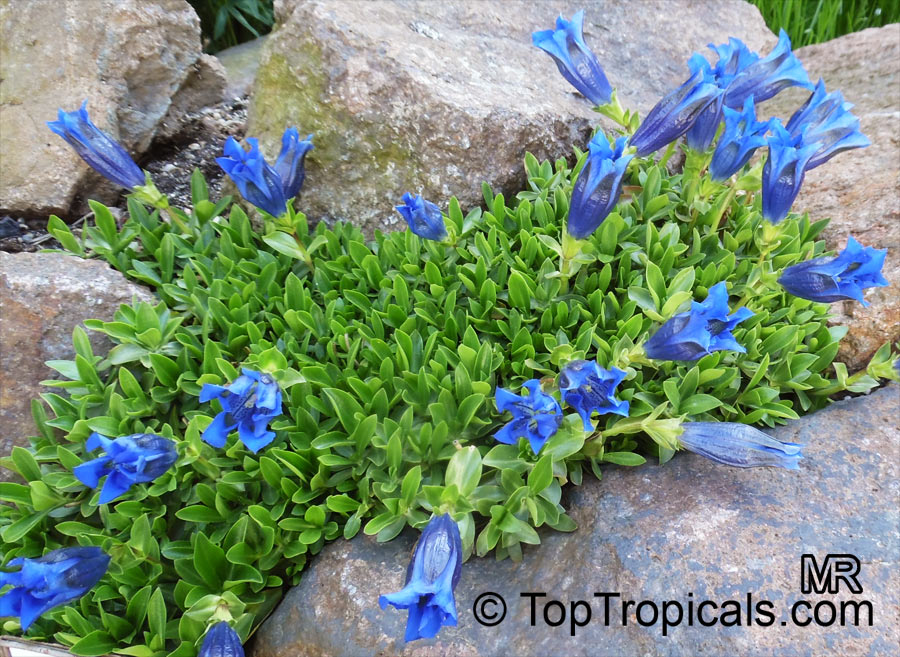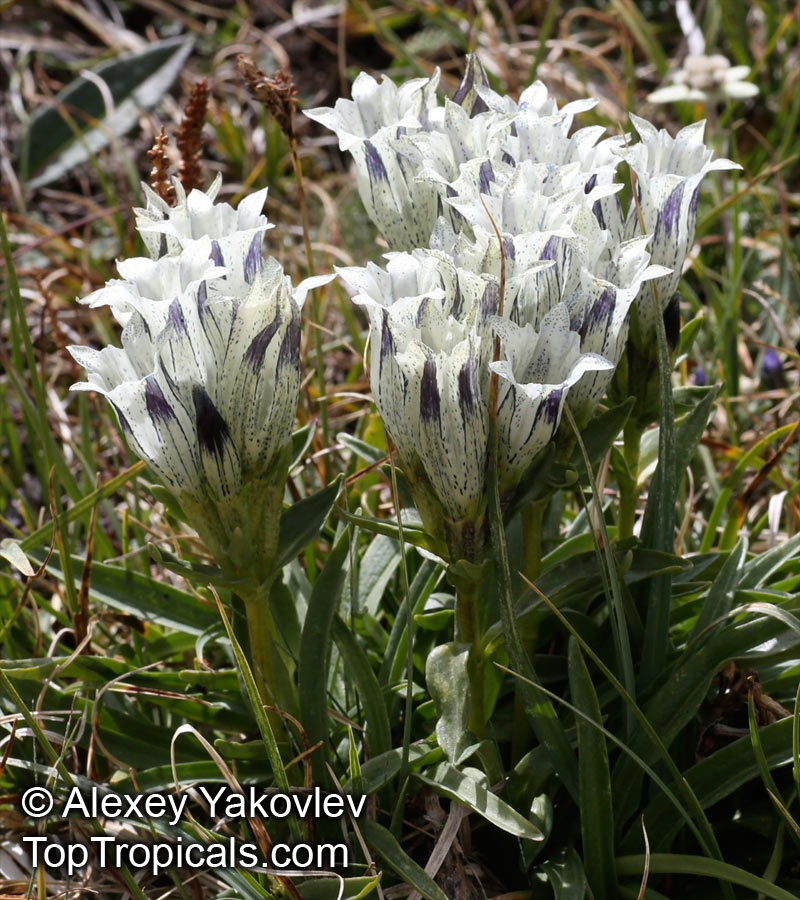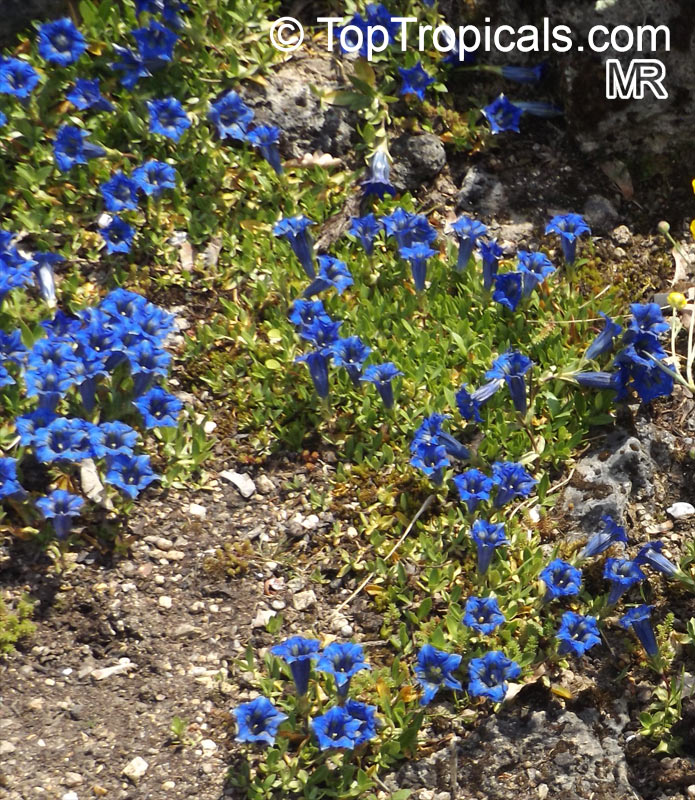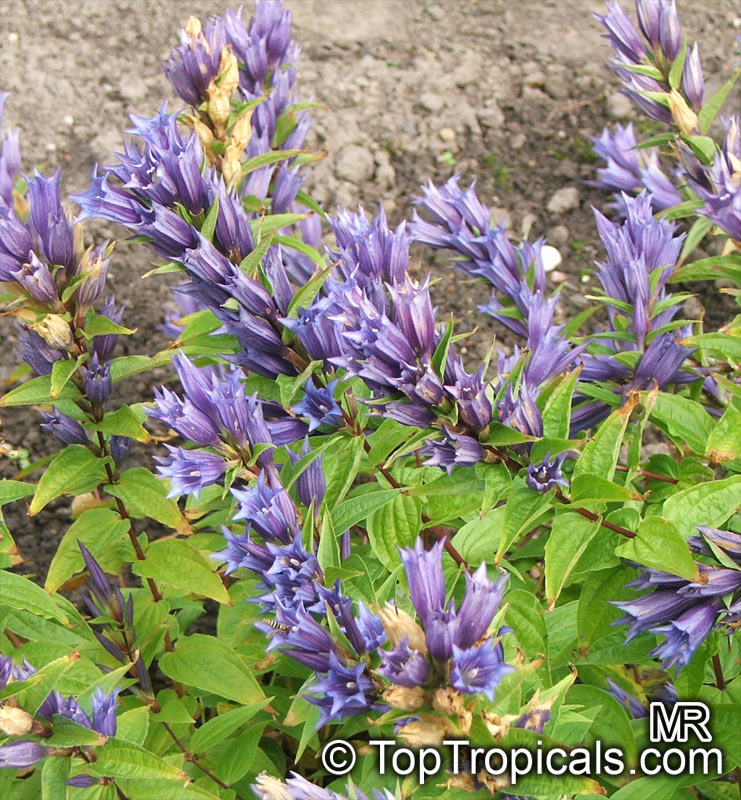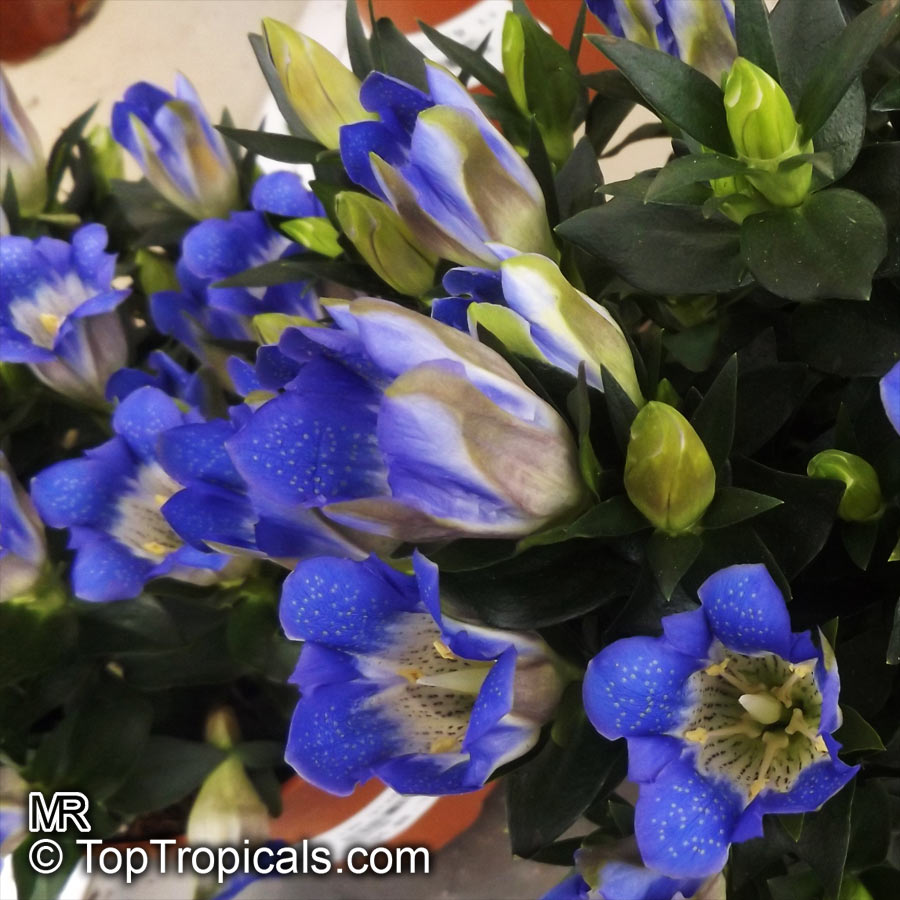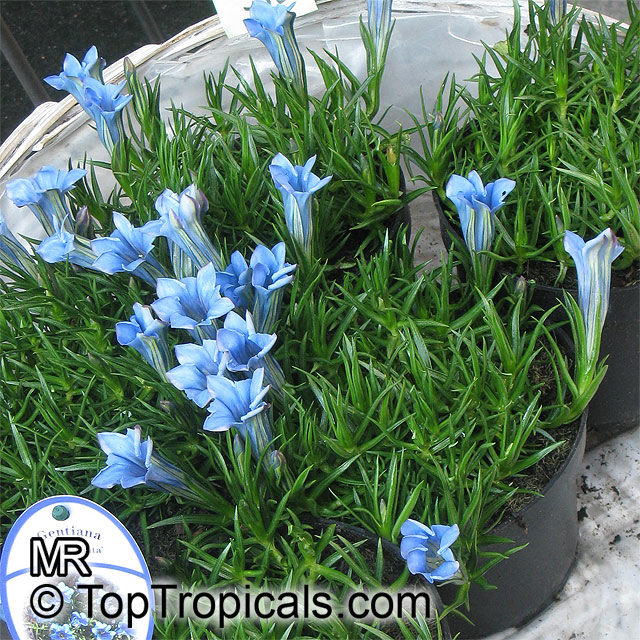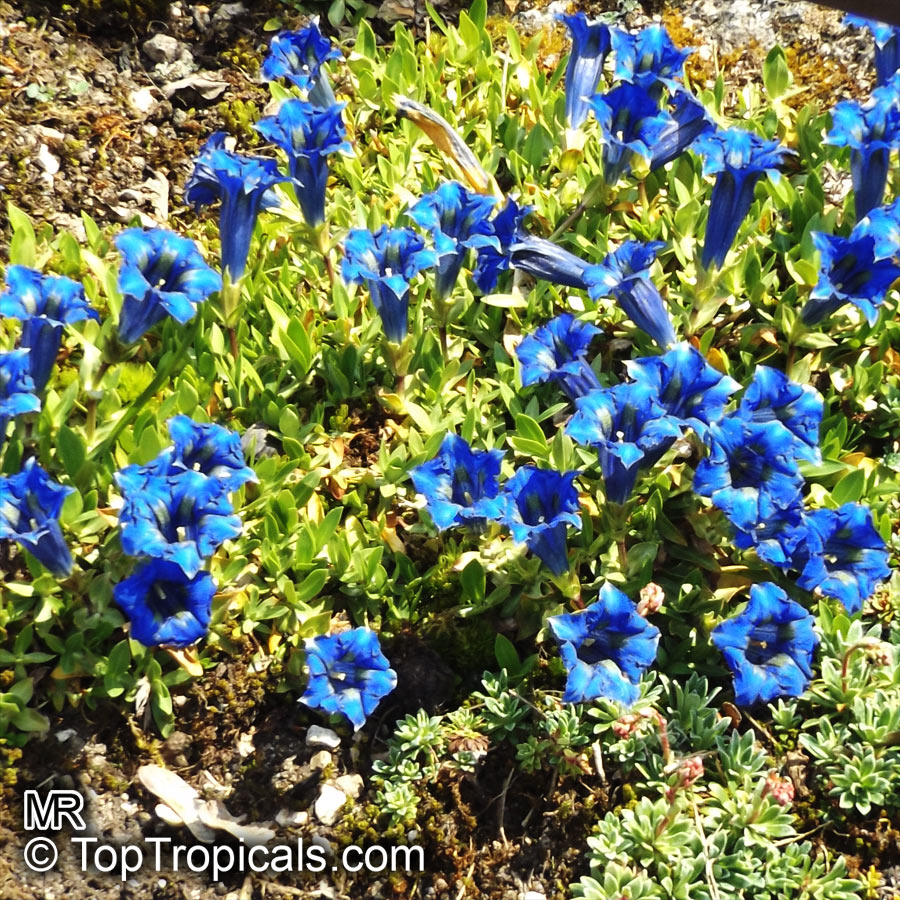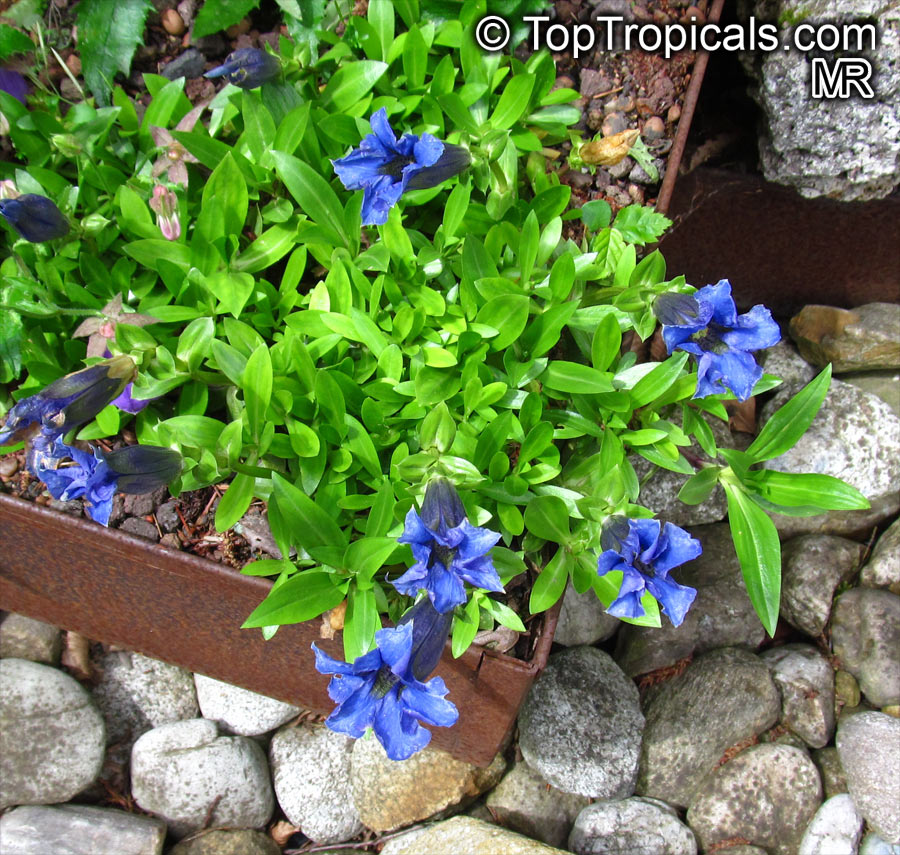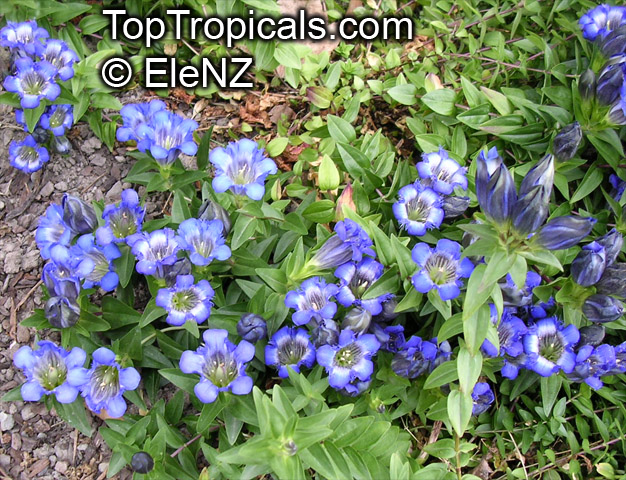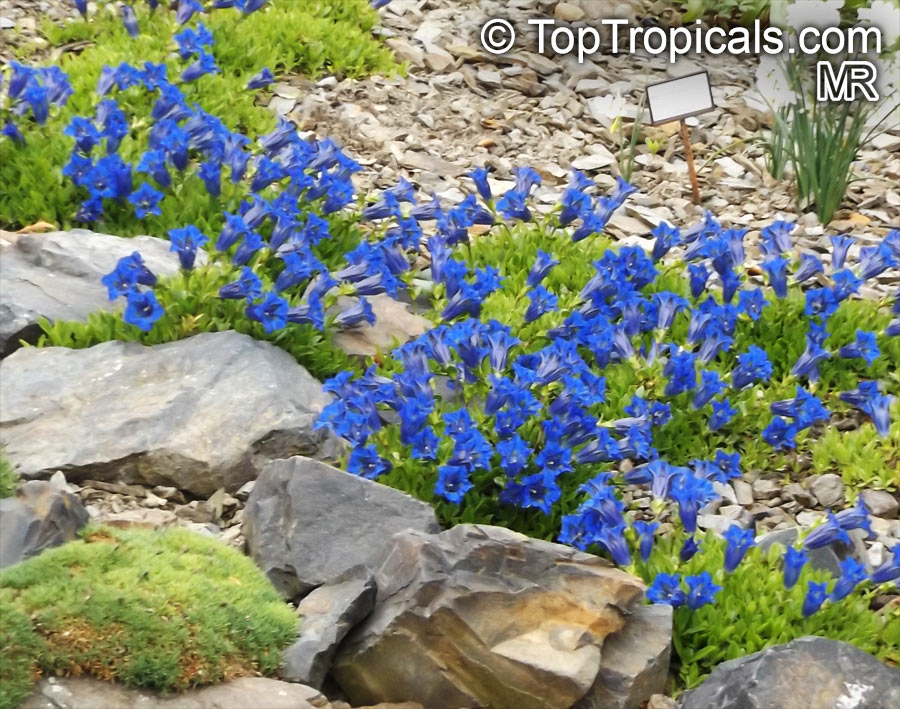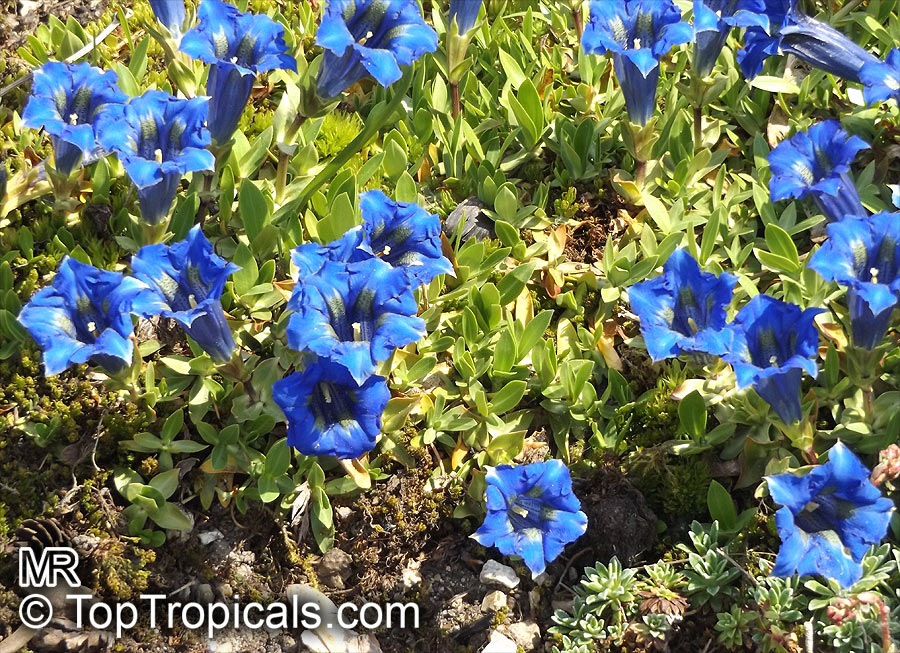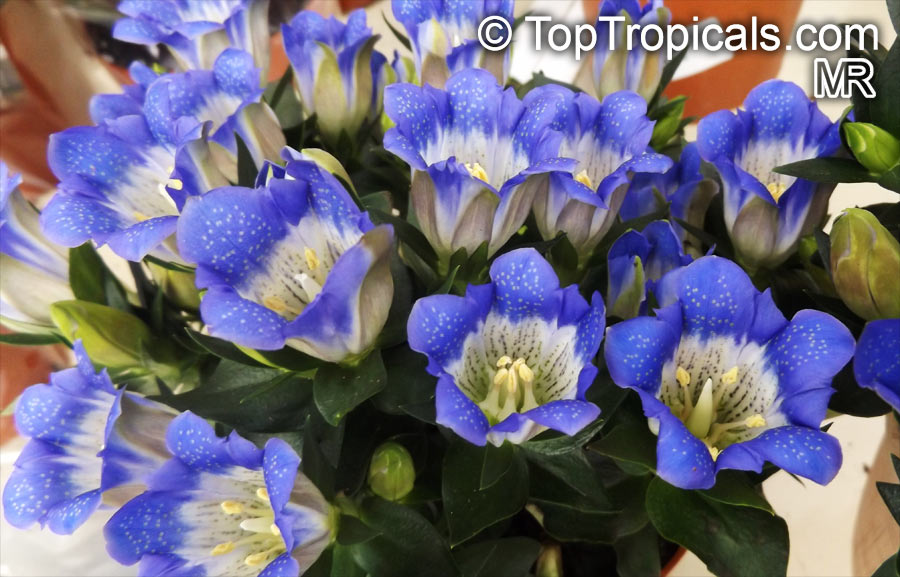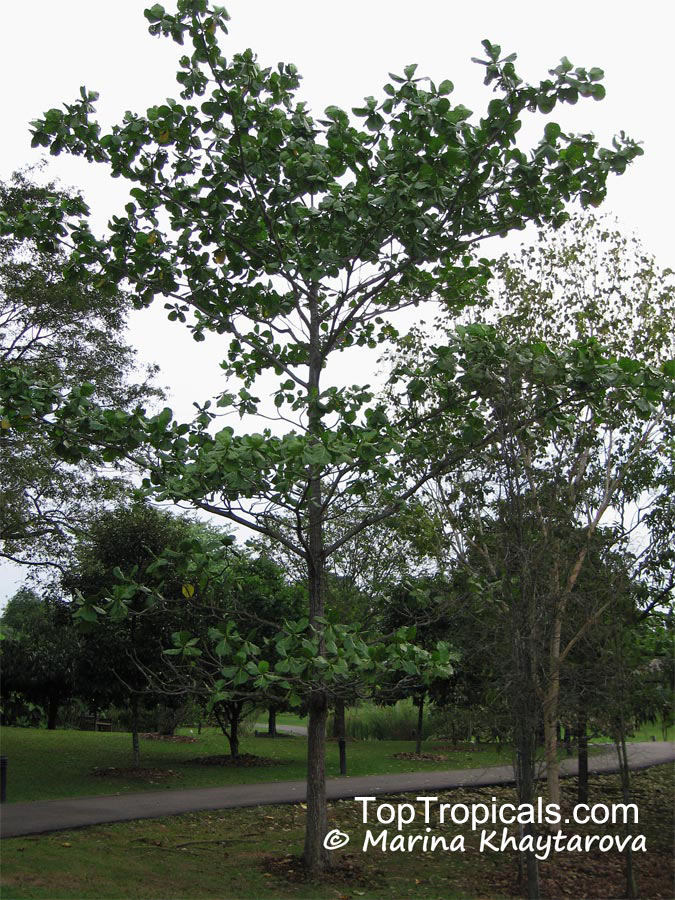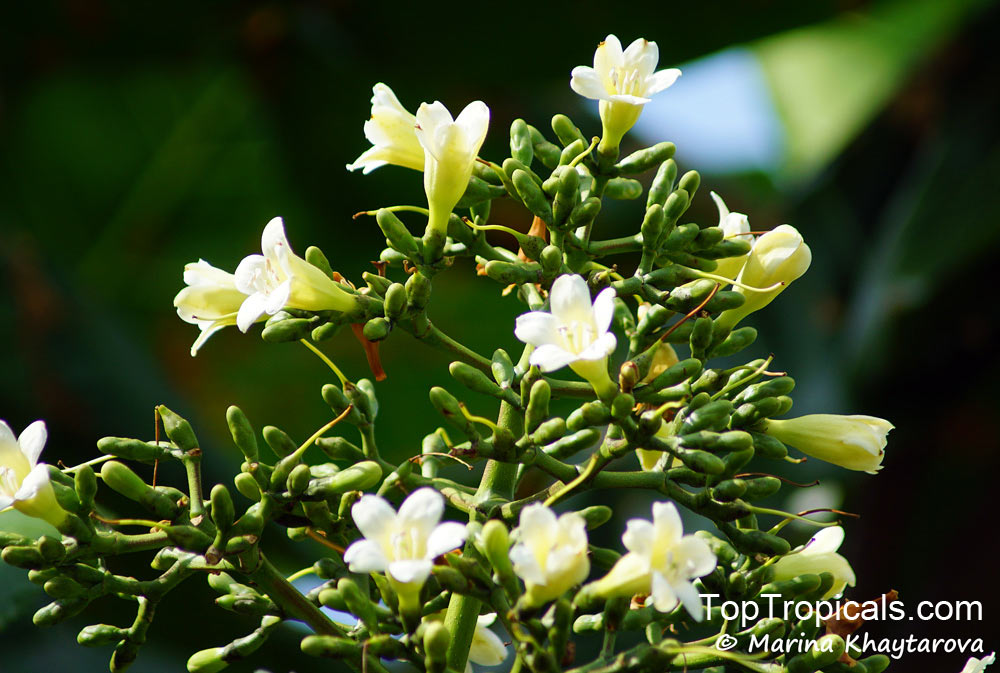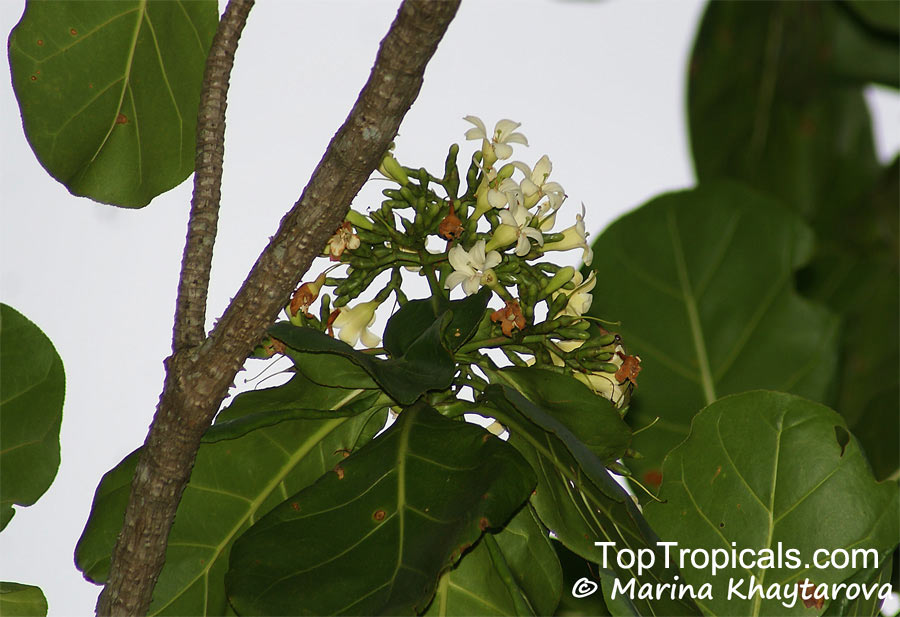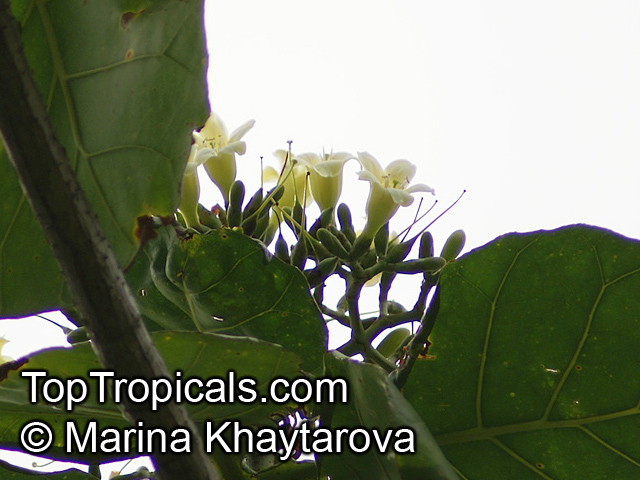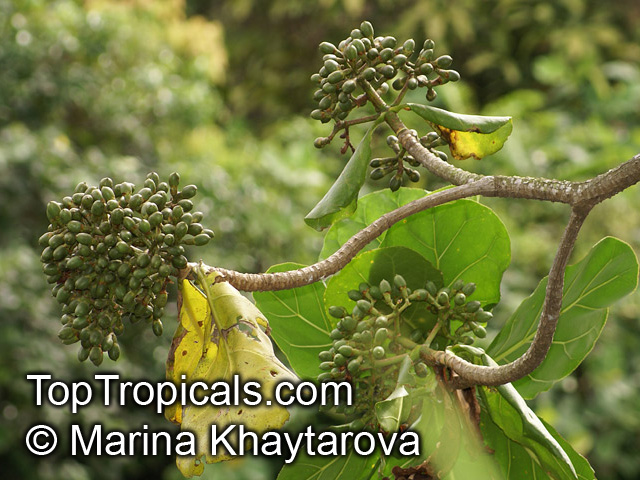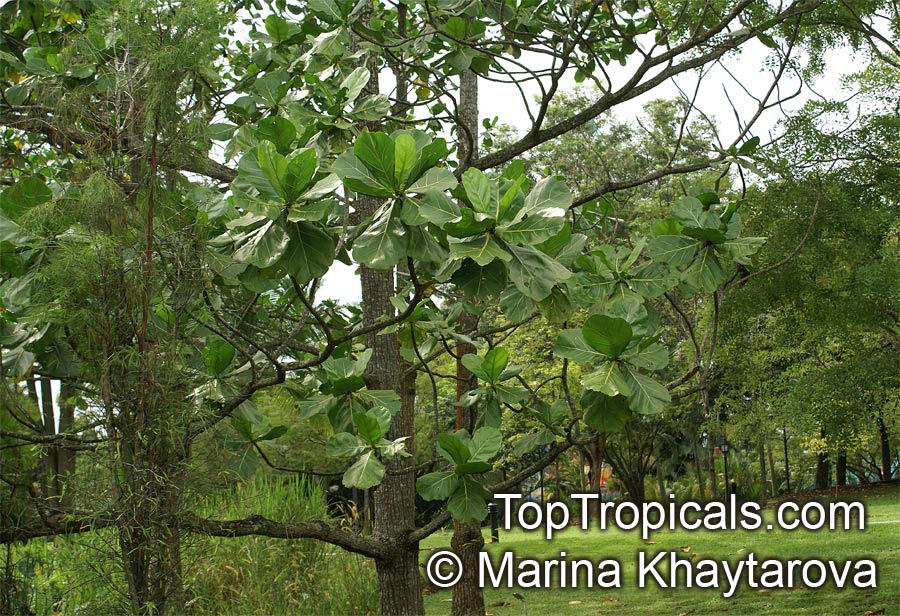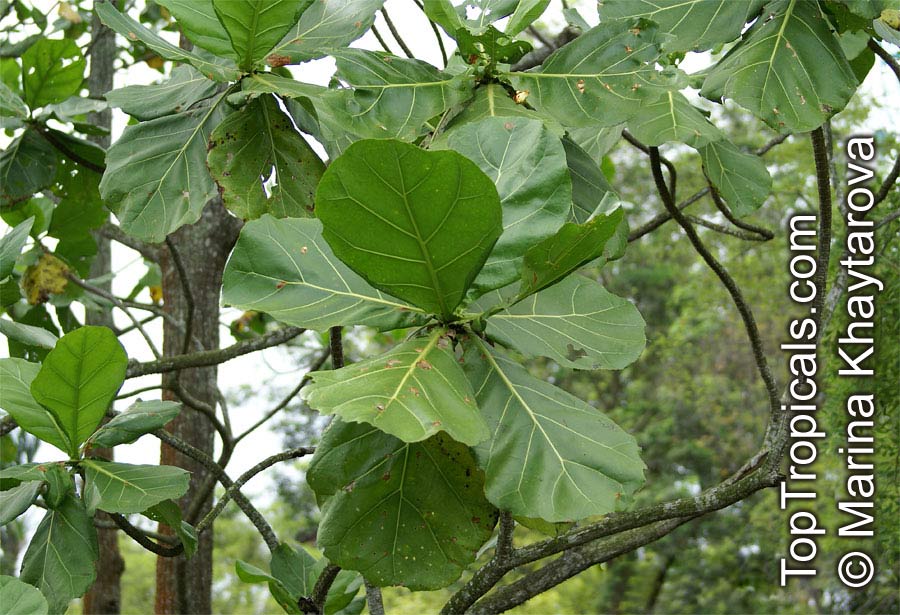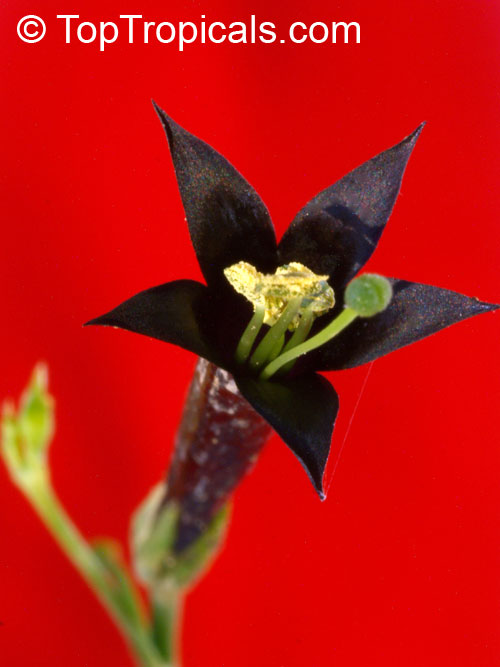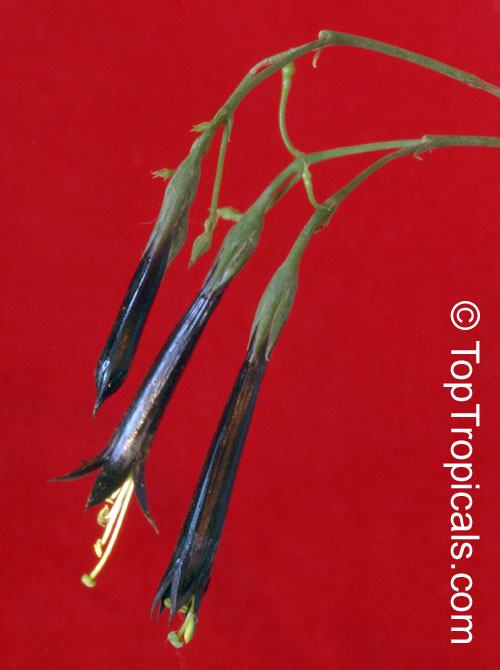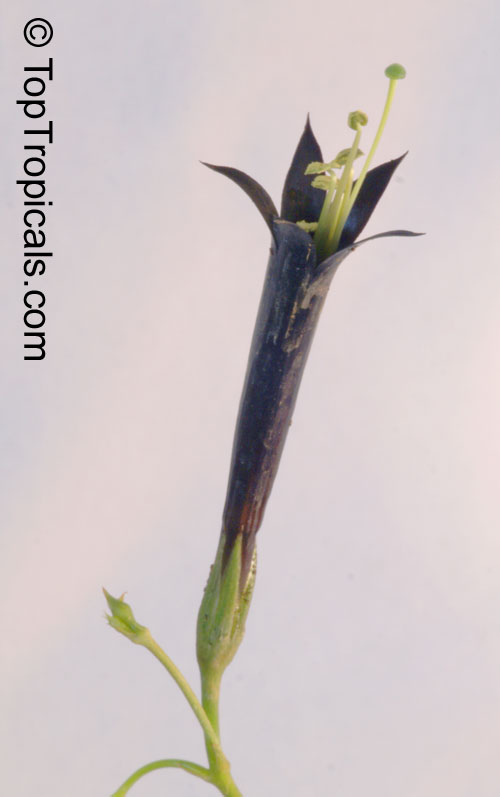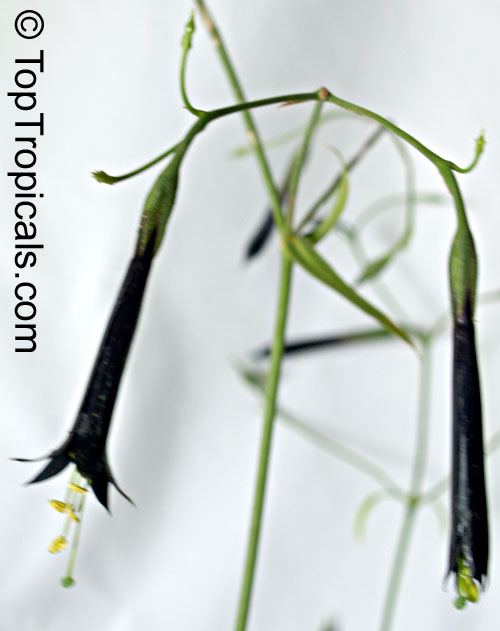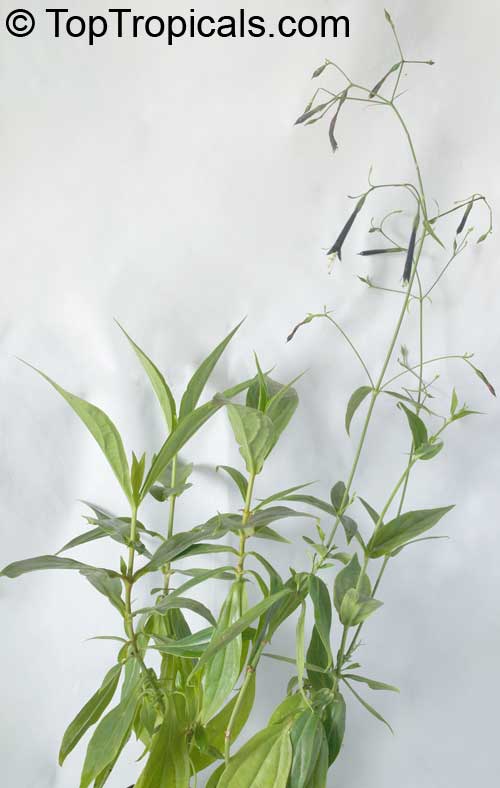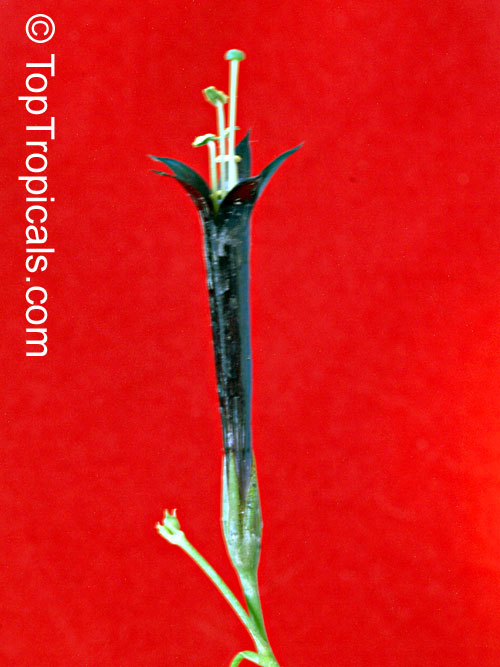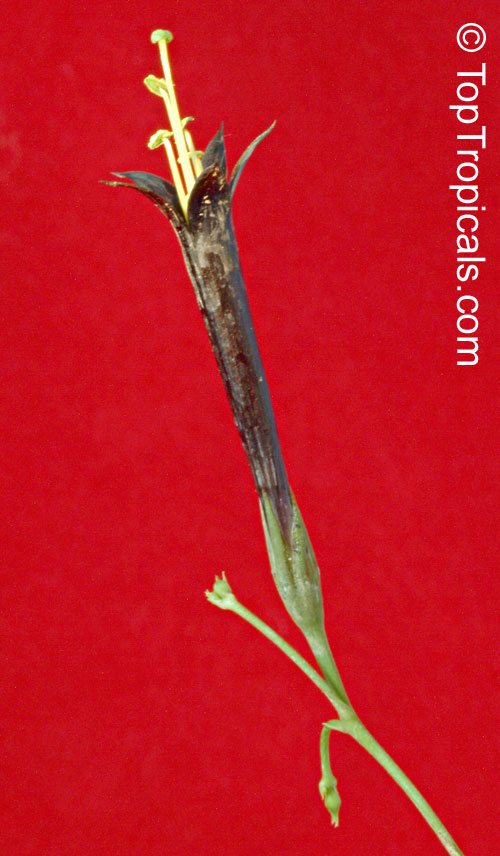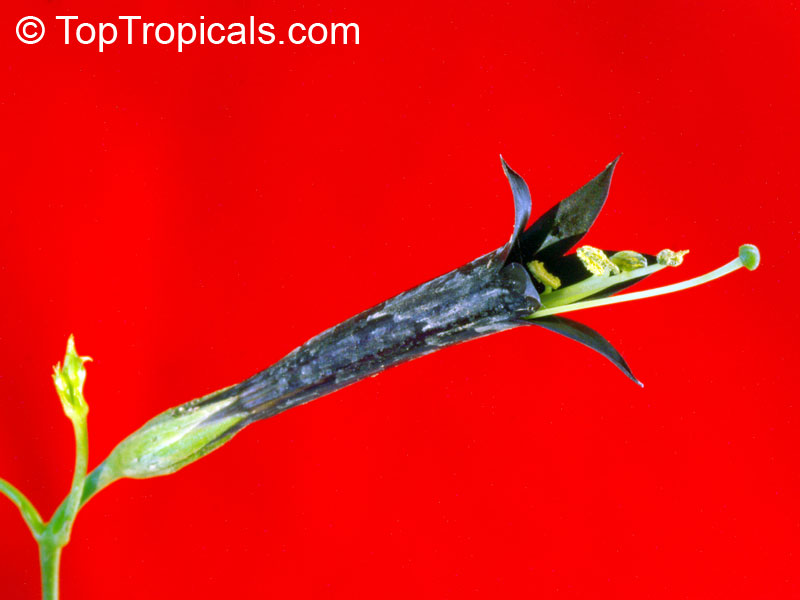Gentianaceae - Botanical Family
Top Tropicals Plant Encyclopedia
| Number of plants found: 12 | Next | 
|
Go to page: | 1 | 2 |
Botanical name: Centaurium erythraea
Common names: European Centaury, Bitter Herb
Family: Gentianaceae
Origin: Europe








Centaurium erythraea is an erect biennial herb reaching up to half a meter in height. It grows from a small basal rosette and bears a leafy, erect stem which can branch. Opposite triangular leaves are arranged on the stem and erect inflorescences emerge from the stem, often intricately intertwined with foliage. Each inflorescence contains multiple small, pinkish-lavender flowers - typically around one centimeter in diameter, flat-faced and with yellow anthers.
This plant is native to Europe, but is also found in North Africa, Eastern Europe, parts of Asia and as an invasive species in North America. It grows 2-5 feet tall and should be planted in full sun or semi-shade. Regular watering is essential, as it does not tolerate floods or extended drought. The flowers bloom in summer and may need staking for wind-support.
Centaurium erythraea has long been used for its medicinal properties. Traditional Chinese medicine uses it as an astringent, diuretic and for the treatment of autoimmune diseases. It is employed for the treatment of anemia, digestive issues, infections and liver problems.
Centaurium erythraea is hardy in USDA Zones 1-9
This low maintenance, tropical shrub is ideal for garden or yard decoration. With proper pruning, its natural form can be formed. When in full bloom, Centaurium erythraea displays impressive bright pink flowers capable of captivating attention. With the right amount of care and coverage for the roots, it will blossom again year after year.
Botanical names: Eustoma grandiflorum, Lisianthus russelianus
Common names: Texas Bluebell, Lisianthus, Tulip Gentian
Family: Gentianaceae
Origin: Texas and Mexico







Eustoma grandiflorum is a striking small shrub native to Texas and Mexico, originally found in Western USA and later selected in Japan as a garden variety. Grown in well-drained soil rich in organic matter in full or semi-shade. This small shrub grows 2 to 5 feet tall and two feet wide with narrow green leaves similar to larkspur.
The plant is a biennial or a half-hardy annual and is hardy to USDA Zone 9-11. Commonly referred to as a Texas Bluebell, Eustomas require either regular or occasional watering and need well-drained soil that is rich in organic matter in full sun or semi-shade. They are drought tolerant and have narrow green leaves that are similar to larkspur.
In May, the Texas Bluebell will produce its beautiful pink, white, off-white, blue, lavender, and purple flowers which will light up any outdoor space for the entire summer. The flowers can range from simple to double-bloomed depending on the variety and make a stunning cut flower. Moreover, the shrub can grow up to five feet tall and two feet wide, adding to the appeal of any garden.
When grown in colder regions, Eustomas should be grown in pots and will require a bit of extra care. They need to be moved or brought indoors when the temperature drops to between 45F - 50F. They will also need extra protection such as a frost cloth on extra cold nights. During the winter, the plants should be watered minimally and placed in a bright, sunny window. When the weather starts warming up, they can be re-planted outdoors.
Botanical name: Exacum affine
Common name: Persian Violet
Family: Gentianaceae
Origin: Island of Socotra off the Southern Arabian Peninsula






Exacum affine, or Persian Violet, is a small herbaceous biennial plant. Leaves are dark green, ovate to 1 to 5 inches long. Plants with great age will reach 2 foot tall. They make a great houseplant and in USDA zone 7 they are used in landscaping as annuals. Blooming Time: Seeds of the plant sown in mid-winter will bloom in the summer, and seeds sown in the fall will bloom in the spring. The small bluish-lilac star-shaped flowers with deep yellow stamens are mildly fragrant. They are very showy.
Botanical names: Fagraea auriculata, Fagraea borneensis, Fagraea bracteosa, Fagraea epiphytica, Fagraea javanica
Common name: Pelir Musang
Family: Gentianaceae (Formerly:Loganiaceae)
Origin: Southeast Asia







Fagraea auriculata is a large, tropical and subtropical shrub that is native to Southeast Asia. It can grow up to 5 to 10 ft tall and is usually found in semi-shade or full shade.
The Fagraea auriculata has fragrant, off-white or white flowers that typically bloom in spring and then again in the late summer. These showy flowers attract butterflies and hummingbirds, making this shrub a great addition to any garden.
When it comes to taking care of Fagraea auriculata, it prefers regular watering, depending on your local climate. It loves humidity, so if you live in a dry area you may need to water more often. Additionally, this shrub loves fertile soil, so adding organic matter to the soil will help your shrub thrive.
Fagraea auriculata can be grown in USDA zones 9-11. In colder regions, it can be grown in a large pot and brought indoors in the winter. Keeping your shrub in a pot will also allow you to move it if you need to. When bringing your shrub indoors during the winter, make sure to keep it away from any drafty windows and radiators. Place your shrub in a room with indirect, but bright, light and water regularly. Note that the plant may go dormant during the winter months.
Overall, Fagraea auriculata is a beautiful and easy to care for shrub that will bring color and life to your garden. With its showy, fragrant flowers and attractive foliage, it is sure to be a welcomed addition.
Botanical name: Fagraea berteriana
Common names: Perfume Flower Tree, Pua Keni Keni
Family: Gentianaceae (Formerly:Loganiaceae)
Origin: South Pacific









Specimen tree or shrub. Can be a large shrub or pruned to a small tree. Amazingly fragrant. All parts are poisonous. Grows into a small spreading tree or a large shrub; the branches quad-angular, with blunt tipped leaves and amazingly fragrant 3" tubular shaped flowers of creamy white which turn golden orange as the day longs. Flowers are popular for making Lei's. Pua Keni Keni in Hawaiian translation means "ten cent flower" which is what the flower once sold for. Sub-tropical to tropical growing conditions. Hardy to the high 40's. Toxic to animals.
According to other sources, belongs to Family Gentianaceae.
Botanical name: Fagraea ceilanica
Common names: Perfume Flower Tree, Pua Keni Keni, Trai Tichlan, Lau binh, Gia
Family: Gentianaceae (Formerly:Loganiaceae)








Fragrant creamy-white flowers of this small tree are up to 10 cm long, last for only a day, but fill the space around with delicate sweet scent. Can be grown as a small tree or compact bush in container. When planted in ground, will form a dense large shrub. Leaves are leathery and glossy, very pleasant to touch. Perfect exotic accent to a small yard or patio. The plant will tolerate some shade and can be successfully grown indoors. Blooms on and off year round. This plant is very rare and hard to find, propagation is not easy. Cuttings root very slowly, within 6-7 months. Toxic to animals.
Botanical names: Fagraea fragrans, Cyrtophyllum fragrans
Common names: Tembusu, Ironwood
Family: Gentianaceae (Formerly:Loganiaceae )
Origin: Burma to Indomalesia








The Tembusu is an evergreen tree native to Southeast Asia. It is slow-growing, medium-sized with a conical crown, sometimes being no more than a shrub. Very fragrant creamy white tubular flowers have a distinct aroma and the fruits of the tree are bitter tasting red berries, which are eaten by birds and fruit bats.
This is a highly variable species. The trunk of this tree can produce very hard wood that can be used to make chopping boards. The wood can last over 100 years, particularly as termites and weevils do not eat this kind of wood. People always use this wood for creating the floors of their homes and love to sleep on it. The tree yields a high-quality timber and excellent fuel and charcoal. It is planted in reforestation and soil stabilization programs and is also often planted as an ornamental and shade tree in parks and along roads.
Close related species:
F. gigantea - a large canopy tree with more regularly fissured bark and leaves that have an undulating margin and only 5 - 6 instead of around 8 pairs of secondary veins.
F. wallichiana - with broader leaves, larger flowers, and larger more ellipsoid fruits
Botanical name: Gentiana sp.
Common name: Gentian
Family: Gentianaceae
Origin: Asia, Europe and the Americas








This is a cosmopolitan genus, occurring in alpine habitats of temperate regions of Asia, Europe and the Americas.
True sapphire blue upward-facing 2" flowers mingle with the emerald green foliage producing long-blooming garden treasures. Flowers sparkle with the morning dew. Prolific flowering occurs up and down the stems on each node from midsummer into early fall. The smooth, mid-green, lance-shaped leaves form a nice sized clump that is perfectly proportioned for the middle of the flower border. Compact and well-branched habit. A charming addition to the hard to find "blues" in perennials. Easier to grow than most Gentians, this beauty sends up a multitude of flowers, often blooming right into fall. Prefers full sun to part shade, but should be protected from the afternoon sun in regions with hot, humid summers. Well-drained soil with average moisture.
Botanical names: Limahlania crenulata, Fagraea crenulata
Common names: Cabbage Tree, Malabera
Family: Gentianaceae (Formerly:Loganiaceae)
Origin: Malaysia







Botanical name: Lisianthius nigrescens
Common names: Flower of Death, La Flor de Muerto, Black Lisianthus
Family: Gentianaceae
Origin: Mexico, Oaxaca, Guatemala






Lisianthius nigrescens, also known as the Flower of Death or "La flor de muerte," is a small perennial native to Mexico and Guatemala. It is characterized by its lanceolate leaves and bell-shaped flowers that are a unique shade of black. It can grow up to 2 feet high and is used as a groundcover plant.
The Flower of Death thrives in full sun but can also tolerate some shade and semi-shade. It requires regular watering during the growing season, but once established, it can withstand periods of drought. It is hardy in USDA zones 9-11 and can be grown in pots in colder regions as long as the soil is well drained and the plant is kept in a warm spot during the winter.
Black flowers are incredibly rare, which is what makes the Flower of Death so special. It is known as "La flor de muerte" due to the local custom of planting it around graves northern Oaxaca, Mexico.
| Next |  |
Use link to repeat this search:
https://toptropicals.com/cgi-bin/garden_catalog/cat.cgi?search_op=and&keyword_op=and&language=e&family=Gentianaceae
&number=10&no_change_lang=1&user=tt&sale=1&first=0
